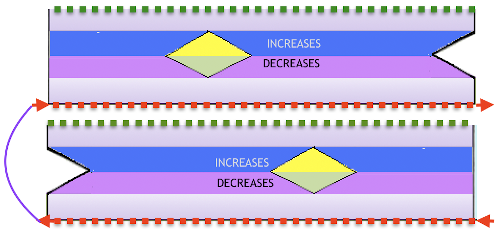Reducing figurative designs to repeats for knitting on a low needle counts results in loss of definition.
Filet crochet charts can serve as a starting point for repeats, but usually are planned on more than equivalent 24 stitch counts, so results of adapting them are often usable on electronic machine models only.
The knitting technique used to execute the design determines whether the lengthwise aspect ratio is affected or not.
1: the source image
2: processed using Mac Numbers
3: opened in Gimp
4: the grid color can be altered to view and match stitch counts
5: the color reversed image to visualize the possible appearance of doing so in the knit
6: a small border frame is added, bringing the figure color to the edges of the knit piece, and the figure is mirrored, helping to make a choice about its orientation on the the knit side 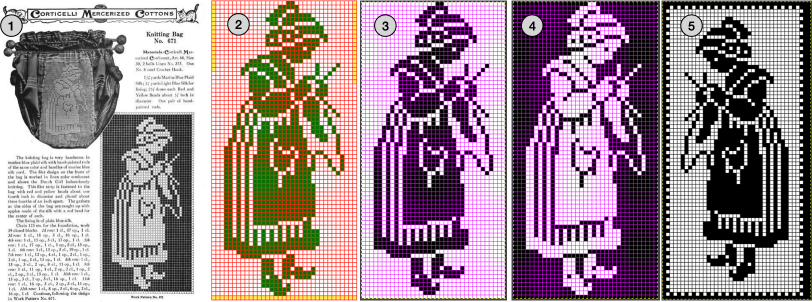 Depending on the model machine used, the motif may appear as drawn on the purl or on the knit side, mirroring it when direction matters may be done using machine settings or mirroring before download.
Depending on the model machine used, the motif may appear as drawn on the purl or on the knit side, mirroring it when direction matters may be done using machine settings or mirroring before download.
On my 930 mirroring was not necessary, the swatch was knit on 40 stitches, with the added frame.
The figure alone, 35X72 pixels ![]() shown on 6X6 grid blocks
shown on 6X6 grid blocks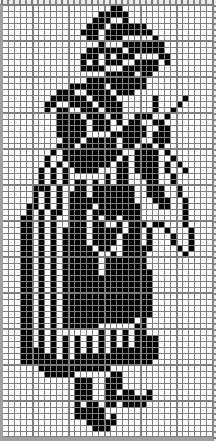 A DBJ swatch with birdseye backing
A DBJ swatch with birdseye backing 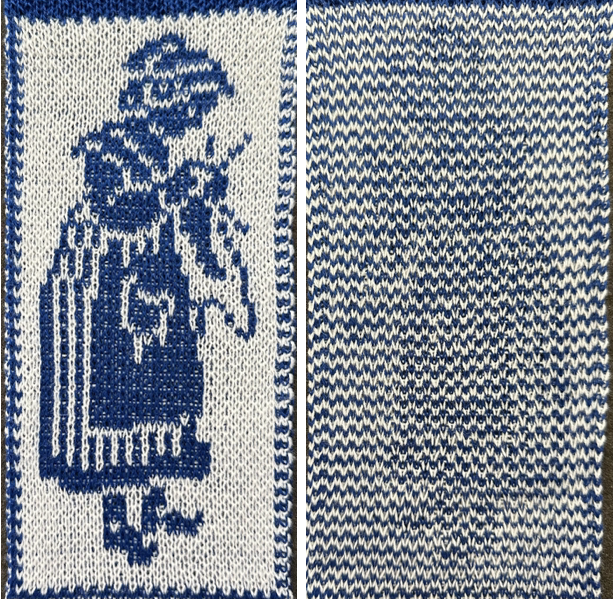 A sitting companion, inspired by random Pinterest find, processed using ArahPaint, not knit tested, 49X65 pixels
A sitting companion, inspired by random Pinterest find, processed using ArahPaint, not knit tested, 49X65 pixels ![]() shown on a 5X5 pixel grid
shown on a 5X5 pixel grid 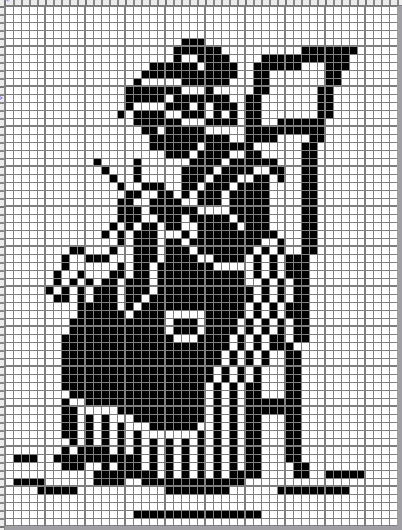 Graduating to pillow or blanket size, a bit of romance in advance of February, from a Priscilla Filet Crochet book, the original was in a nearly oval format.
Graduating to pillow or blanket size, a bit of romance in advance of February, from a Priscilla Filet Crochet book, the original was in a nearly oval format.
A border was added to complete the original to full oval shape,
black pixels were added to complete the inner shape, and the BW image was extracted and saved.
Working in RGB mode, the border needs to be adjusted for symmetry, not fully complete here, and bucket pattern fill may be used to customize it or any frame 
 the 117X154 modified oval chart and png
the 117X154 modified oval chart and png 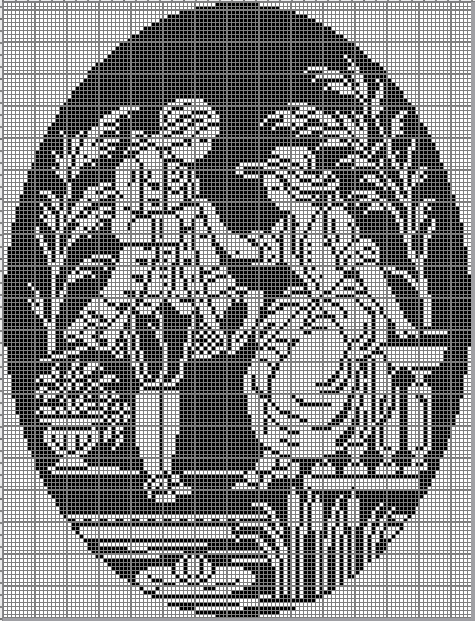
 color inverted 107X154 for DIY modifications to other shapes
color inverted 107X154 for DIY modifications to other shapes  A 137X184 RGB version with editable border
A 137X184 RGB version with editable border 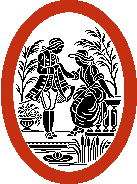 Mythological inspiration from a Priscilla source
Mythological inspiration from a Priscilla source
A: the original
B: processed with GIMP
C: processed with Arah 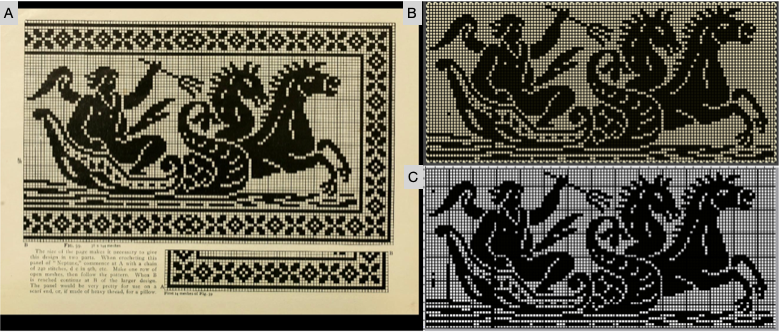 the final png chart, with some pixels removed
the final png chart, with some pixels removed  and the 118X54 png
and the 118X54 png  A 142X81 pixel version that includes a border
A 142X81 pixel version that includes a border  From previous posts:
From previous posts:
74X54 Celtic design 
43X53 squirrel ![]() This image is not from a filet crochet chart but from one of my Studio 560 mylar sheets dating back decades. It is used to illustrate the possibility of mirroring in different directions to produce far larger designs ie wall hanging or blankets.
This image is not from a filet crochet chart but from one of my Studio 560 mylar sheets dating back decades. It is used to illustrate the possibility of mirroring in different directions to produce far larger designs ie wall hanging or blankets.
Alone it could serve as a scarf, with the image rotated and perhaps even mirrored at the opposite end of the scarf to match directions when draped around the neck 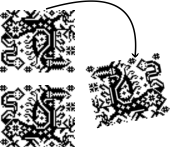 The 60X50 cell repeat
The 60X50 cell repeat  It takes a few clicks of a mouse and a couple of program windows nowadays to make the addition of single cells at the top, bottom, or sides of such large designs that avoid tiling intersections with double cells if that is the goal.
It takes a few clicks of a mouse and a couple of program windows nowadays to make the addition of single cells at the top, bottom, or sides of such large designs that avoid tiling intersections with double cells if that is the goal.
It is also easy to manipulate the chosen designs to visualize the appearance of a final piece. Printing the pixelated results in a larger format can aid informed choices before any actual knitting.
Adding a single cell blank column on the right, and one with a few pixels on the bottom a blank row on the top, 61X52  in a 122X104 repeat that with coordinated borders could approach the use of most of the needle bed
in a 122X104 repeat that with coordinated borders could approach the use of most of the needle bed  with the initial shape mirrored horizontally and then drawn in repeat a column with double pixels appears again at the center of the design
with the initial shape mirrored horizontally and then drawn in repeat a column with double pixels appears again at the center of the design  staying with that, but making shapes go around
staying with that, but making shapes go around 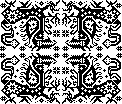

Category: Hand Knitting (HK)
Midjourney inspired knits 1: single bed diamond shaped strips
My son recently introduced me to Midjourney and generated many images capable of inspiring a range of machine knits. The interpretation and execution may not be as simple as would initially appear, particularly to non-knitters.
Commercial knitting machines are left out of this conversation. The fact that they have multiple beds,  and compound needles
and compound needles ![]() that facilitate whole garment shaping makes complex structures possible that may only be partially reproduced on home models.
that facilitate whole garment shaping makes complex structures possible that may only be partially reproduced on home models.
Japanese machines such as mine use two beds, with the ribber/ second bed added for knit and purl combinations, which may be lowered as seen below when not in use, or removed altogether.  One accessory that would make things easier to reproduce more textured knit and purl variations would be a Brother G carriage,
One accessory that would make things easier to reproduce more textured knit and purl variations would be a Brother G carriage, 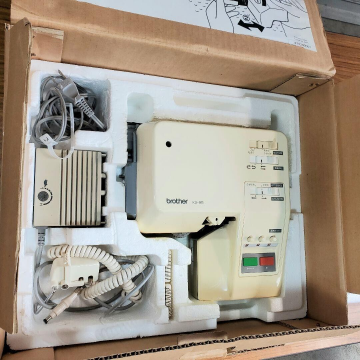 which operates on the top bed and slowly and loudly produces programmed patterns on both punchcard and electronic Brother models.
which operates on the top bed and slowly and loudly produces programmed patterns on both punchcard and electronic Brother models.
The initial Midjourney inspiration,  and a “simpler” variation.
and a “simpler” variation.
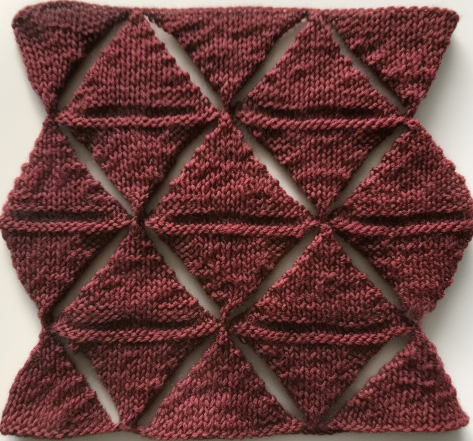 In hand-knitting concurrent shaping of both sides can be considered.
In hand-knitting concurrent shaping of both sides can be considered.
When working on 2 needles, because the work is turned over, knit and purl execution will change when ridges visible on both faces are planned.
Knit stitches are rectangular as opposed to square, often in a 4/3 ratio.
This chart begins to illustrate the actions involved. 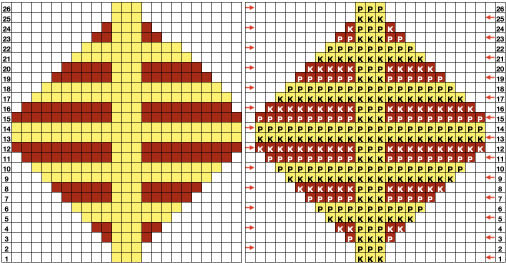 Machine knitters constantly look at the purl side when working on the top bed unless ladders are manually reworked into knit stitches or the work is turned over.
Machine knitters constantly look at the purl side when working on the top bed unless ladders are manually reworked into knit stitches or the work is turned over.
Turning the work over is executable using a garter bar accessory, available for use on multiple gauge machines.  The standard and bulky garter bars offer sections that may be joined together for use on the whole needle bed, while the tool for holding, transferring, or turning over small stitches offers only 30 eyelets, the red lines on it were made with red nail polish, a handy way to mark KM tools or even linkers at fixed intervals to save constant counting.
The standard and bulky garter bars offer sections that may be joined together for use on the whole needle bed, while the tool for holding, transferring, or turning over small stitches offers only 30 eyelets, the red lines on it were made with red nail polish, a handy way to mark KM tools or even linkers at fixed intervals to save constant counting.
The work is pushed off onto the garter bar with the curved ridges up and returned to the machine to create the purl ridges after turning the bar over.
At that time, the needle hooks will grab the stitches from back to front and the bar can be removed.  If the yarn supply is to be kept continuous, the knit carriage and yarn need to be brought to the opposite side before resuming knitting.
If the yarn supply is to be kept continuous, the knit carriage and yarn need to be brought to the opposite side before resuming knitting.
Spreadsheets offer a way of visualizing steps ahead of any swatching. Not aiming for a direct copy of any of the Midjourney results, this is a start with 4-row sequences
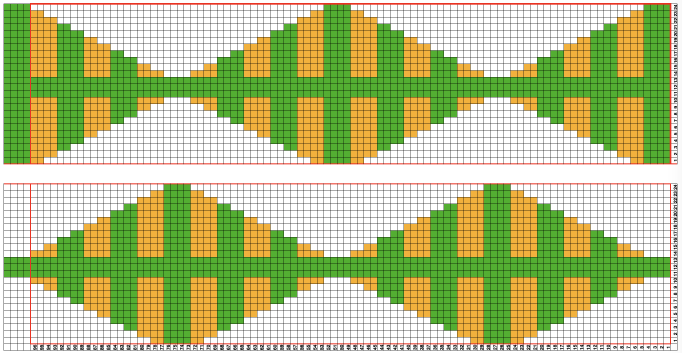 and an illustration of how strips might be joined to produce slightly different side edges.
and an illustration of how strips might be joined to produce slightly different side edges. 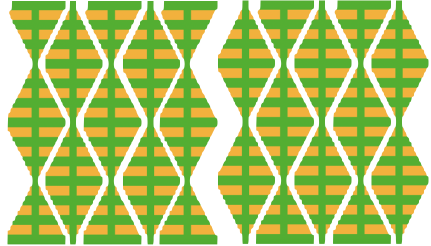 The diamonds are formed by increasing and decreasing on both side edges.
The diamonds are formed by increasing and decreasing on both side edges.
The sample is knit in a 2/8 wool, which even when knitting at tension 9 yielded stitches far too tight to remove onto the standard gauge garter bar, the 30 stitch tool was used.
Stocking stitch tends to roll to the purl side. For a cleaner edge, fully fashioned shaping is used.
From the Brother knitting techniques book, to decrease a stitch:  To increase one
To increase one  If both sides are shaped at the same time, the length may get affected by slight differences in stitch height formations on the carriage side as opposed to opposite the carriage.
If both sides are shaped at the same time, the length may get affected by slight differences in stitch height formations on the carriage side as opposed to opposite the carriage.
In the test swatch increases and decreases were made consistently opposite the carriage, resulting in shaping on alternate sides every 2 rows.
Charting out the concept: the arrows represent the direction the carriage will be moving.
The blank row occurs where the knit is turned over.
A single row is knit across all stitches to the opposite side after the knit is turned before returning to shaping.
The last 2 rows in the chart would be the first 2 in the following shape.
The black cells represent what will become purl rows on the knit ground. 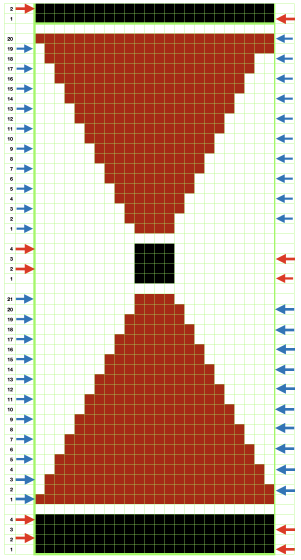 The proof of concept:
The proof of concept:  The machine-knit sample aside from a quick hand-knit on #8 needles, attempting garter ridges, offering a lesson in gauge and texture.
The machine-knit sample aside from a quick hand-knit on #8 needles, attempting garter ridges, offering a lesson in gauge and texture.
In a final piece, the shaping in the hand-knit would be carefully considered.  A first draft plotting out arrangements for alternating knit/ purl ridges: the center column can be adjusted to any width, and cables or other manipulations could occur at the narrow pivot points.
A first draft plotting out arrangements for alternating knit/ purl ridges: the center column can be adjusted to any width, and cables or other manipulations could occur at the narrow pivot points.
Seaming or joining would occur in areas where rows are outlined in blue. Those areas could be lengthened as well.
The chart can be further marked for beginning with either a half or a full diamond. For hand knitters, the yellow cells would be purled with knit side facing, and knit with purl side facing.  A Youtube video showing building the fabric using the short row technique: https://www.youtube.com/watch?v=H7WrYOV2A6w&t=1297s
A Youtube video showing building the fabric using the short row technique: https://www.youtube.com/watch?v=H7WrYOV2A6w&t=1297s
For anyone with intarsia or multicolor fondness, some AI color renditions based on triangles as well 
On a very different note, large, nonrepetitive AI-generated portrait images may be superimposed with brushes in any chosen design repeat to render designs such as these: 

Seaming, joining, picking up stitches 3, ribbed knits
These illustrations are not my own work, they were taken from various out-of-print Japanese published resources including manuals for different machine brands, or handouts received decades ago, in the days of international machine seminars, and altered and resized.
For more information on seaming and joining also see the previous posts: Seaming, joining and picking up stitches on knits 2, which includes some illustrations on joining ribs as well
Seaming, joining, picking up stitches on knits 1
The plan here is to provide additional illustrations for joining ribbed stitches in various configurations so as to maintain the stitch arrangement 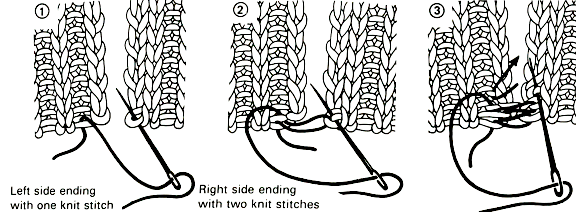

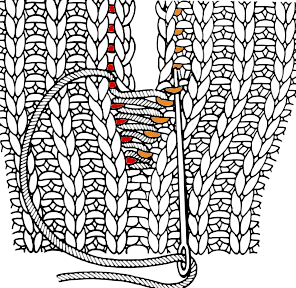
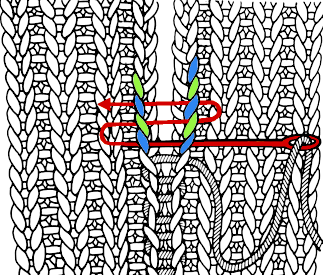 rib join through the edge loops of knit stitches
rib join through the edge loops of knit stitches  2X2 rib ending with one stitch
2X2 rib ending with one stitch  2X2 rib join ending with 2 stitches
2X2 rib join ending with 2 stitches 
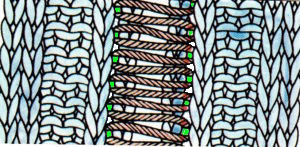 2 X 2 rib join ending with 2 purl stitches, 1 full stitch from the edge
2 X 2 rib join ending with 2 purl stitches, 1 full stitch from the edge 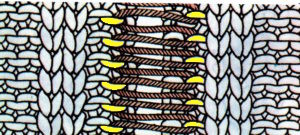 Attaching ribs to garments: it often is best to weave under and out of single bars at a time, particularly in bulkier knits and in short ribbed edgings. If the stitches are small, it is possible to weave under bars 2 at a time, always test on swatches before committing any technique to a garment.
Attaching ribs to garments: it often is best to weave under and out of single bars at a time, particularly in bulkier knits and in short ribbed edgings. If the stitches are small, it is possible to weave under bars 2 at a time, always test on swatches before committing any technique to a garment.
In A there is a fully formed knit stitch on each edge while in B, some shaping may be seen. The gauge for the ribbed fabric vs stocking or other techniques may be quite different, so in joining, it may be necessary to adjust sequences of pick-ups on either side in order to ease any differences in fabric lengths and maintain a smooth, flat join.  Attaching to a V-neck, adjusting for shaping
Attaching to a V-neck, adjusting for shaping 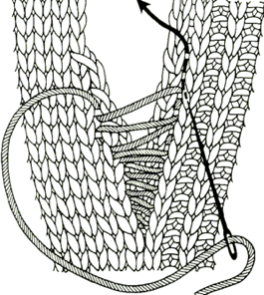
Visualizing knit cables 3_ using Numbers and Gimp
As our knitting experience grows, there are likely to be some techniques that engage us and others we choose to avoid completely if possible. Cables are in the latter category for me. I have hand-knit complicated pieces using them but dislike knitting them on the machine immensely. That said, I am periodically drawn to revisiting the topic in my blog, the resulting swatches are as proof of concept.
Small crossings may be used in sequence to create more complex cables, and charts illustrating them may be simplified, using little or even no added color.  The repeat is 8X8 and the above movement can be seen in the purl view.
The repeat is 8X8 and the above movement can be seen in the purl view.
Ladders and knit columns between vertical sets of cables make the process easier to track, one needs to be alert to accidentally bringing the ladder back into work resulting in knit stitches, seen in the bottom left of the knit side swatch.  A spreadsheet table may be created to help with tracking multiple series of cables across a knit and their direction. It can contain as little or as much information as one wishes. Included here: the RC for possible crossings, and their direction on the purl side for machine knitting (reversed for hand knitting). Columns may be added including how many needles are left in or out of work between cable knit spaces or other info.
A spreadsheet table may be created to help with tracking multiple series of cables across a knit and their direction. It can contain as little or as much information as one wishes. Included here: the RC for possible crossings, and their direction on the purl side for machine knitting (reversed for hand knitting). Columns may be added including how many needles are left in or out of work between cable knit spaces or other info. 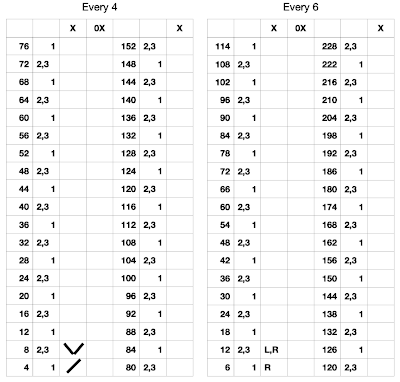 It is also possible to print a custom needle tape to place underneath the involved groups of needles instead of marking the needle tape or the knit beds. On a standard km, the needles are 4.5mm apart. A conversion reference for needle spacing point values
It is also possible to print a custom needle tape to place underneath the involved groups of needles instead of marking the needle tape or the knit beds. On a standard km, the needles are 4.5mm apart. A conversion reference for needle spacing point values  Four needles X 12.75 =51 points, the width of the table cells, which in this instance are all equal in size. Colors and any other info may be added within each cell. Print in landscape orientation, making certain the image is not set to fit the page, but at 100%.
Four needles X 12.75 =51 points, the width of the table cells, which in this instance are all equal in size. Colors and any other info may be added within each cell. Print in landscape orientation, making certain the image is not set to fit the page, but at 100%.
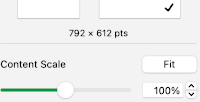
 A narrower series of twists are made after every 2 rows knit, the chart shows crossings on the purl side on the left, as opposed as to how they would appear on the knit side on the right
A narrower series of twists are made after every 2 rows knit, the chart shows crossings on the purl side on the left, as opposed as to how they would appear on the knit side on the right 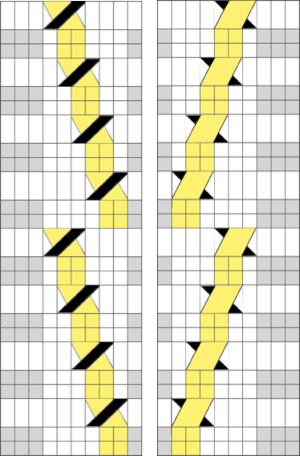
 Which leads to the topic of creating shapes by combining the repeats
Which leads to the topic of creating shapes by combining the repeats  A brief effort containing at least 5 errors leads me to wonder about programming needle selection to help track crossings more easily and avoid mistakes. The center ladder here was latched up during knitting.
A brief effort containing at least 5 errors leads me to wonder about programming needle selection to help track crossings more easily and avoid mistakes. The center ladder here was latched up during knitting.  Adding the ribber: the simplest knits using the ribber are made with transfers to the ribber of single or multiple stitches to create what is sometimes called trailing stitches, with cables occurring at determined distances and appearing as knit stitches on a purl ground. Some samples of elongated ribber stitches with crossings on a striped ground may be found in the post on Slip stitch patterns with hand transferred stitches, double bed, the technique may be executed in a single color, or as shown here with color changes every 2 rows.
Adding the ribber: the simplest knits using the ribber are made with transfers to the ribber of single or multiple stitches to create what is sometimes called trailing stitches, with cables occurring at determined distances and appearing as knit stitches on a purl ground. Some samples of elongated ribber stitches with crossings on a striped ground may be found in the post on Slip stitch patterns with hand transferred stitches, double bed, the technique may be executed in a single color, or as shown here with color changes every 2 rows.  If only the knit stitches or purl stitches are crossed on one the same bed when knitting ribs, they will appear so on one side only. One example
If only the knit stitches or purl stitches are crossed on one the same bed when knitting ribs, they will appear so on one side only. One example  If the start is on the top bed, stitches on the ribber may be created by picking up bars from the top bed
If the start is on the top bed, stitches on the ribber may be created by picking up bars from the top bed  the yarn above was a 2/8 wool, which refused to cable on the ribber, and having the crossing was preferred to not
the yarn above was a 2/8 wool, which refused to cable on the ribber, and having the crossing was preferred to not  changing to a thinner wool-silk solved the problem.
changing to a thinner wool-silk solved the problem.  Using a punchcard or electronic program to track movements and cabling on the knit bed, each stitch in each pair of punched holes or pixels is crossed over or under the other. This is a very time-consuming fabric, not friendly to distractions or interruptions. Any crossing mistakes in the swatch were due to “operator error”.
Using a punchcard or electronic program to track movements and cabling on the knit bed, each stitch in each pair of punched holes or pixels is crossed over or under the other. This is a very time-consuming fabric, not friendly to distractions or interruptions. Any crossing mistakes in the swatch were due to “operator error”. 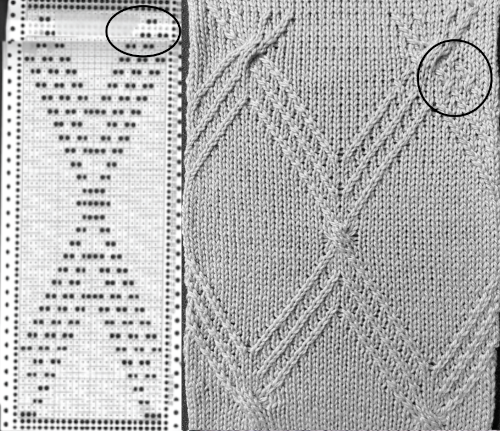 In reviewing the post after linking to it here I realized the now marked punchcard error at its top. The amended longer chart reworked in Numbers is also added to the older post. It is shown here aside from its tiled chart, checking for alignment, a habit developed as my skill and comfort in using spreadsheets grew,
In reviewing the post after linking to it here I realized the now marked punchcard error at its top. The amended longer chart reworked in Numbers is also added to the older post. It is shown here aside from its tiled chart, checking for alignment, a habit developed as my skill and comfort in using spreadsheets grew,  A png of the repeat, 24 stitches wide by 72 rows
A png of the repeat, 24 stitches wide by 72 rows ![]() Tiled for alignment in Gimp as well.
Tiled for alignment in Gimp as well.
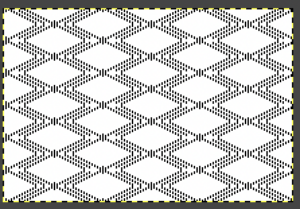 It is possible to use the repeat working 1 X 2 stitch crossings for a very different look.
It is possible to use the repeat working 1 X 2 stitch crossings for a very different look.
A large swatch is worth doing before committing to a large piece.
Correcting crossing errors (purple arrows) after the fact will be harder than doing so in some other instances or in a bulkier knit.
Keeping the fabric visible as opposed to between the beds begins to show a pattern on the reverse, which can also guide the direction of movements.
There are spots in this repeat where the center larger cables are not possible because of cables in opposite directions already occurring on either side of the group of selected needles (red arrows).
Transfers occur by bringing single needles forward and crossing pairs of stitches behind them, moving away from the center of the triangular half of the diamond as it is formed. The sequence is retained until after the wider cabled segments occur (black arrow and line), where there is no other needle selection aside from stitches to be crossed.
The number of plain knit stitches between crossings is always even.
The cabled knit areas have a depth that makes them project out and appear almost beaded in texture.  Assigning colors to crossings in a chart may be helpful or too much info depending on one’s perspective, the bottom of the repeat is on the right.
Assigning colors to crossings in a chart may be helpful or too much info depending on one’s perspective, the bottom of the repeat is on the right. 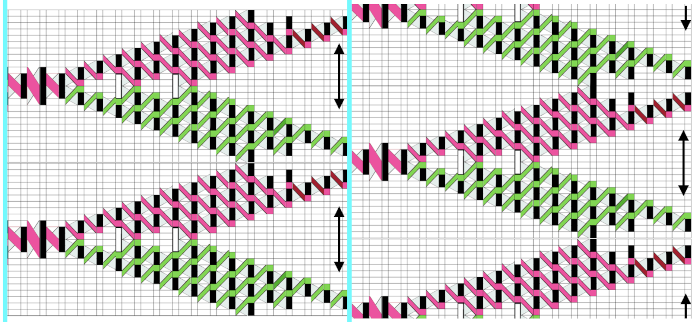
Periodically, the topic of reversible cables turns up in discussions for both hand and machine knitting. They are possible when working in ribbing on the knitting machine.
Keep in mind that ribs narrow when off the machine, cables do as well, so a looser tension is generally required, and the basic fact that knit stitches are purl stitches on the other side and vice versa.
Cable crossings are made over purl stitches that separate them or the reverse. Changing rib needle arrangements will result in fabrics that may not always “match”, appearing different on one side from the other.
Using the half-pitch position before any transfer rows brings needles closer together, G carriages may be a boon but may have a hard time knitting the row immediately following the cable crossings and even jam.
On the machines, a 3X3 crossing is likely to be the limit. A general starting guide when trying out repeats is to knit the same number of rows between crossings as there are stitches in the cross, so 6 rows knit before a 3X3 cable.
A published illustration of bringing the ribber into play.  Creating extra slack if possible on the row before stitches are moved is helpful here as well as when working on the single bed.
Creating extra slack if possible on the row before stitches are moved is helpful here as well as when working on the single bed.
Stitches may be crossed on either or both beds. If trying that out, crossing on one bed, knitting a row, then crossing on the other is another thing to try. As with any ribber fabric, the view of results is limited, dropped stitches may be easily missed.
A straightforward idea to test: in a wide vertical rib make cables on both beds, testing whether it is necessary to reverse the direction of the crosses or not, the number of rows to knit plain, etc. The chart shows a staggered arrangement. The number of rows between crossings can be changed to suit.  In my first test crossings occur on both beds and on the same row. Even using the thinner blue yarn at maximum tension the transfers were hard to execute. I had more success when I added 2 empty needles between the vertical ribs and brought one on each side of each rib into work on the top bed prior to knitting the last row between transfers, creating a bit of extra yarn to ease the crossings.
In my first test crossings occur on both beds and on the same row. Even using the thinner blue yarn at maximum tension the transfers were hard to execute. I had more success when I added 2 empty needles between the vertical ribs and brought one on each side of each rib into work on the top bed prior to knitting the last row between transfers, creating a bit of extra yarn to ease the crossings.
After the row is knit the same needles are pushed back to A position, dropping the yarn, and crossings are made before continuing to knit.
Results vary depending on the yarn, tension, machine model, and operator patience. The arrows mark the location of what appears to be a damaged needle, the tuck stitches were not deliberately planned.  Here the repeats are staggered, the edge with the ladder close to the end stitch is shown again to be far less stable than the one with more knit stitches. Spacing is varied, exploring the tolerance for the yarn to be crossed. The setup while working:
Here the repeats are staggered, the edge with the ladder close to the end stitch is shown again to be far less stable than the one with more knit stitches. Spacing is varied, exploring the tolerance for the yarn to be crossed. The setup while working:  If transfers are made after every 5 rows knit, crossings on multiples of 10 could be assigned to one bed, while row counts containing the number 5 could be made in the other. Sporadically pairs of transfers on the same bed may provide more surface interest.
If transfers are made after every 5 rows knit, crossings on multiples of 10 could be assigned to one bed, while row counts containing the number 5 could be made in the other. Sporadically pairs of transfers on the same bed may provide more surface interest.
The set up after transfers to top bed prior to binding off 
 Trying out a simple repeat in smaller rib configurations will provide some idea as to whether the technique falls into the love of or not something to do simply because one can.
Trying out a simple repeat in smaller rib configurations will provide some idea as to whether the technique falls into the love of or not something to do simply because one can.
Charting can happen using the same method as in illustrating crossings in color, with some alterations, sometimes less information is more or enough.
The first repeats were knit with most stitches on the main bed, and a 2 stitch ladder on either side of the ribs involved in cabling to help visually with keeping the stitch location constant. The grey, purl cell blocks are as viewed from the back, the white cells represent stitches on the ribber. 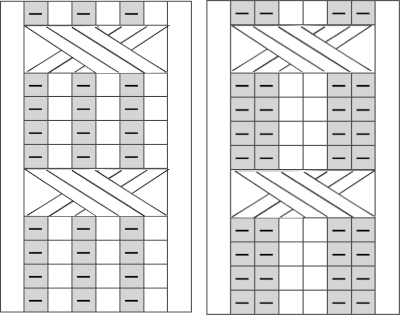 A: the set up single bed, with needles out of work on each side of the planned cable space, tension is tested and 3X3 crossings every 6 rows are made first only on the single bed
A: the set up single bed, with needles out of work on each side of the planned cable space, tension is tested and 3X3 crossings every 6 rows are made first only on the single bed
B. the ribber needle configuration is set up
C. the cables are made after transferring ribber stitches up to the top bed, and then the same stitches are returned down to the ribber before continuing to knit
D. the ribber stitches are transferred up to the top bed, and the swatch was bound off. Note the difference in width in areas where no crossings are made.
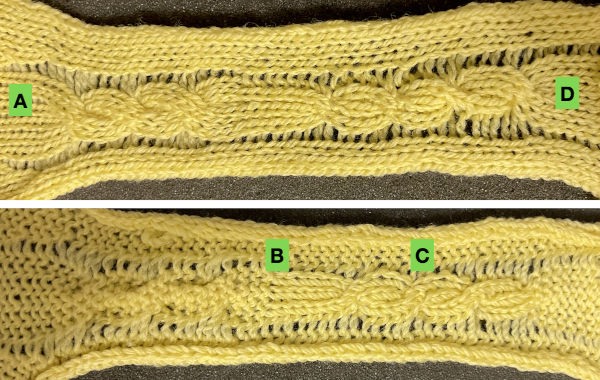 The step-by-step instructions apply to both instances: the chart shows 4 rows knit between crossings, instead, here 6 rows are knit in both tests.
The step-by-step instructions apply to both instances: the chart shows 4 rows knit between crossings, instead, here 6 rows are knit in both tests.
The photos documenting the 2X2 rib: the single bed starting point
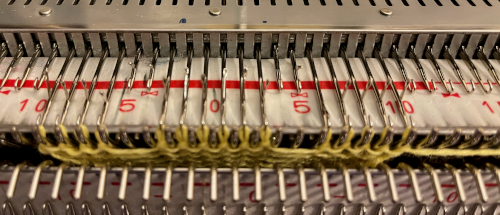 the rib configuration set up
the rib configuration set up  1. after 5 rows knit, bring an extra needle in work on the top bed to pick up extra yarn for the cross
1. after 5 rows knit, bring an extra needle in work on the top bed to pick up extra yarn for the cross  2. drop the extra loop, make certain the empty needle returns to A position
2. drop the extra loop, make certain the empty needle returns to A position  3. transfer all cable ribber needles to top bed
3. transfer all cable ribber needles to top bed 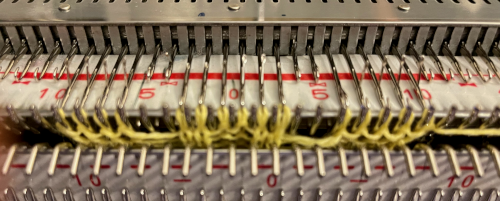 4. cross the stitches with two three-prong tools
4. cross the stitches with two three-prong tools 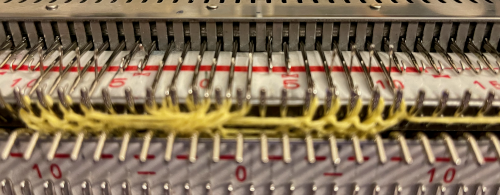 5. transfer stitches back down to the ribber
5. transfer stitches back down to the ribber 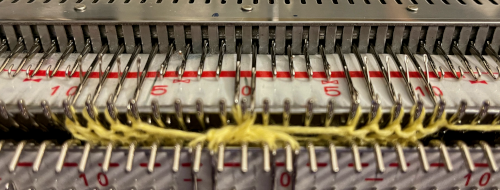 knit 5 rows, repeat steps 1 to 5.
knit 5 rows, repeat steps 1 to 5.
The appearance of each side of the fabric differs
A: the knit was begun on the single bed
B: the ribber configuration was set up
C: cable crossings were made as shown above
D: stitches were transferred to the top bed and bound off 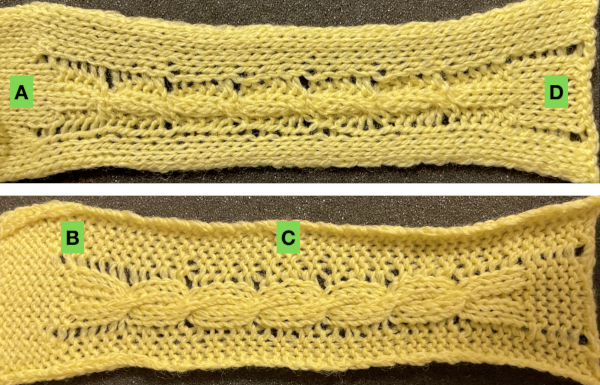 An attempt at a larger swatch using 1X1 ribs:
An attempt at a larger swatch using 1X1 ribs:
the intended concept,  a custom needle tape
a custom needle tape  rib set up for the yellow yarn
rib set up for the yellow yarn  the cable crossings using it were impossible, starting over with a thinner yarn at the same tension
the cable crossings using it were impossible, starting over with a thinner yarn at the same tension  the ribber may be dropped after transfers up to the main bed, keeping stitches and crossings visible, making it possible to make corrections in any cables if they are needed before re-engaging the ribber and transferring stitches back down
the ribber may be dropped after transfers up to the main bed, keeping stitches and crossings visible, making it possible to make corrections in any cables if they are needed before re-engaging the ribber and transferring stitches back down 
 The concept is an interesting one and many arrangements based on the idea are possible.
The concept is an interesting one and many arrangements based on the idea are possible. 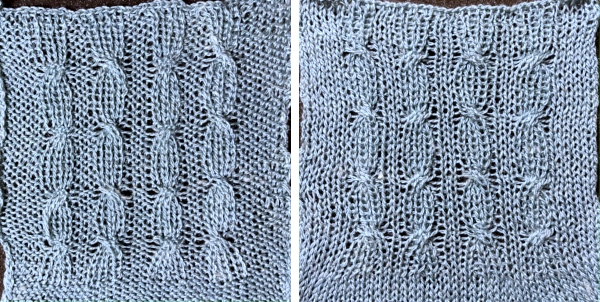 In the above swatches, when any transfers were made to the top bed, after crossings, a row was knit before returning stitches to the ribber. The extra row may or may not be noticeable, depending on the yarn and colors used.
In the above swatches, when any transfers were made to the top bed, after crossings, a row was knit before returning stitches to the ribber. The extra row may or may not be noticeable, depending on the yarn and colors used.
More variants, analyzing columns in color using a crossing over single center stitch first and eliminating the extra knit row, and transferring stitches back down to the ribber immediately after making the cables. The rib will have a tendency to spring back when relaxed and off the machine, so the texture may be hard to see. Using a fiber that allows for some spreading out with some blocking helps to make the work more visible. A reference chart can be developed ahead of time for repeat variations.
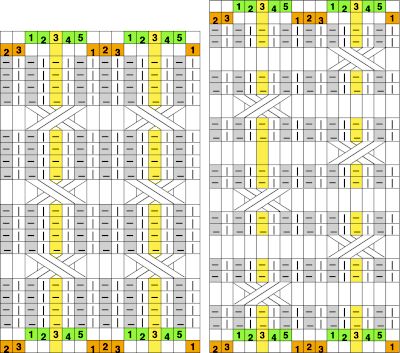 The number of rows between crossings can vary. When the crossing row is reached:
The number of rows between crossings can vary. When the crossing row is reached:
A: stitches are moved up from the ribber to the main bed
B: cable crossings are made
C: stitches that had been moved up are returned back to the ribber, keeping the original ribber needle configuration
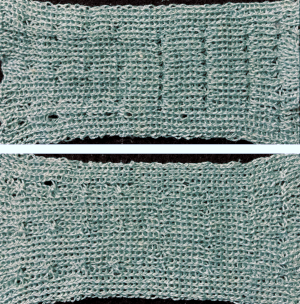
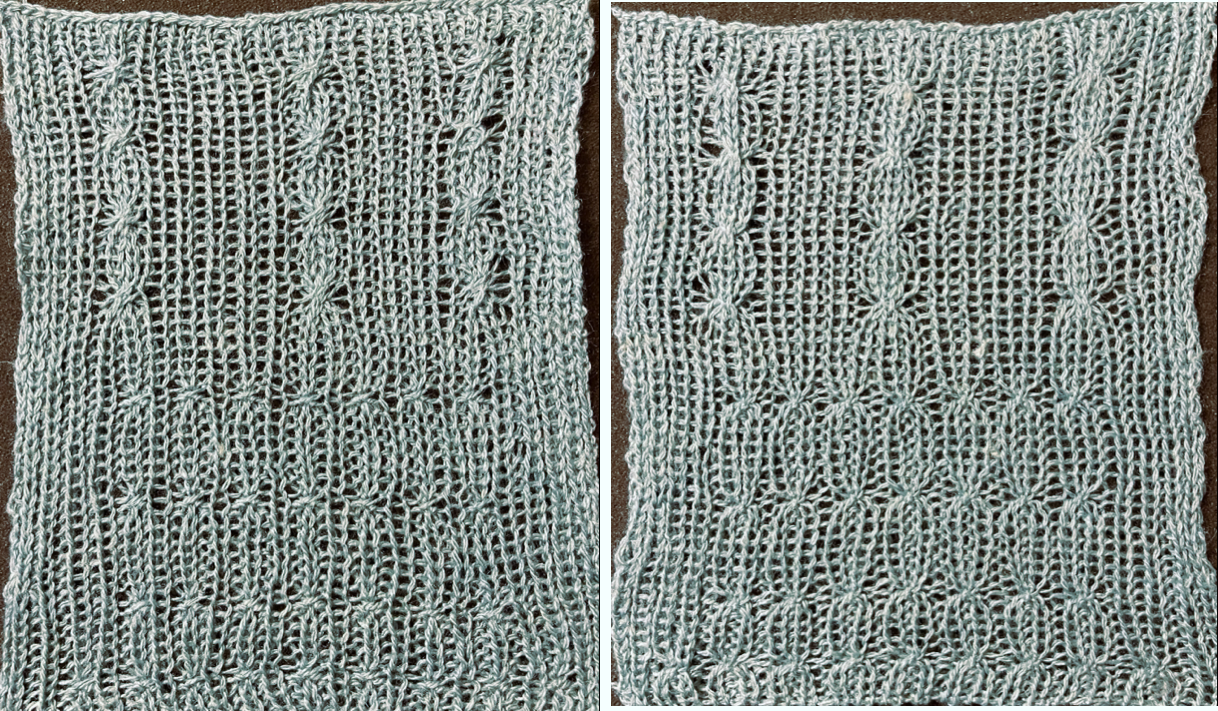 Assigning colors to columns reveals that stitches are not moved onto the same stitch type when moved over a single, undisturbed, fixed center stitch.
Assigning colors to columns reveals that stitches are not moved onto the same stitch type when moved over a single, undisturbed, fixed center stitch.  Shifting the needle arrangements when cabling, moving across a center column of two stitches that remain fixed on the main bed, the cable direction as it would appear on the purl side on the left, the knit side on the right is straightforward here:
Shifting the needle arrangements when cabling, moving across a center column of two stitches that remain fixed on the main bed, the cable direction as it would appear on the purl side on the left, the knit side on the right is straightforward here: 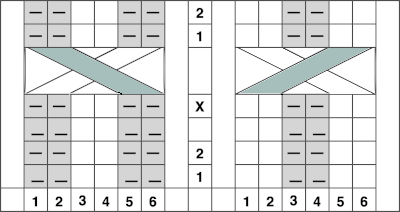 I found the above impossible to knit, even with ladders for extra slack, and the swatch stopped when the yarn broke
I found the above impossible to knit, even with ladders for extra slack, and the swatch stopped when the yarn broke 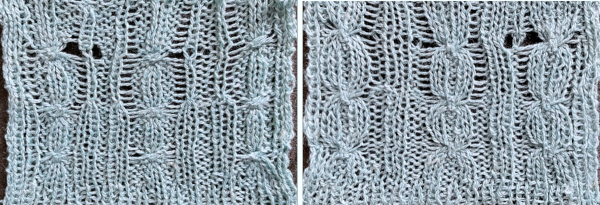 Returning to 1X1 rib, looking at the column alignment in color
Returning to 1X1 rib, looking at the column alignment in color  There appears to be enough slack produced in the formation of stitches between beds to make the planned crossings possible.
There appears to be enough slack produced in the formation of stitches between beds to make the planned crossings possible.
A: the needles transferred to the top bed
B: crossings are made over the 2 center stitches
C: the stitches that had been moved up to the main bed are now returned to the ribber. Bringing cable stitches out and or up to the hold position helps ensure that they will knit properly on the next carriage passes.
The similarity between both sides of the fabric is increased

 From a Brother pub, small crossings for a smocked effect
From a Brother pub, small crossings for a smocked effect  The same approach may be used to create fabrics in tubular tuck patterns, easy to execute in one color. Once yarn, possible crossings, and their minimum frequency have been determined, the start of far more complex shapes can be explored using colors to represent the necessary direction of movements before any decisions are made has to how frequently to cross the cables and to get some idea of negative spaces created between traveling stitches. In hand knitting, a purl ground is easier to plan and maintain.
The same approach may be used to create fabrics in tubular tuck patterns, easy to execute in one color. Once yarn, possible crossings, and their minimum frequency have been determined, the start of far more complex shapes can be explored using colors to represent the necessary direction of movements before any decisions are made has to how frequently to cross the cables and to get some idea of negative spaces created between traveling stitches. In hand knitting, a purl ground is easier to plan and maintain. 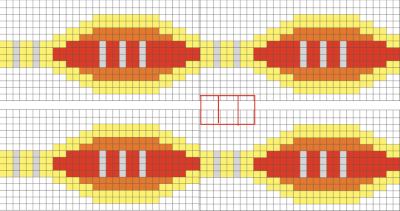
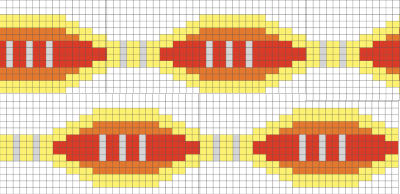 Adding and removing rows in the tables or even changing colors is easy and quick in a spreadsheet, tiling in repeat with scaled screengrabs provides a quick reference for possible improvements/corrections before any actual knitting takes place
Adding and removing rows in the tables or even changing colors is easy and quick in a spreadsheet, tiling in repeat with scaled screengrabs provides a quick reference for possible improvements/corrections before any actual knitting takes place 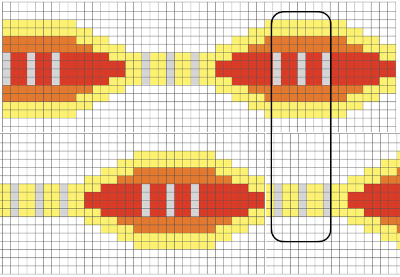
Visualizing knit cables in color 2_ using Numbers and Gimp
Though this post presents cable movements in colors using multiple stitches, the resulting repeats may be knit by hand or at times on the machines in single color textures and the number of stitches in any column may be reduced or expanded, keeping the direction of the cable crossings the same.
Though DIY charting may not be your goal, perhaps the charts themselves will inspire similar stitch movements. Segments of any of the charts may be clipped, saved, and manipulated for easy versions of other options.
My first published experiment with cables created in vertical columns of alternating colors was in 2012,  A quick way to imagine variations of the same pattern is to choose segments of the swatch photo and alter their direction and/or placement
A quick way to imagine variations of the same pattern is to choose segments of the swatch photo and alter their direction and/or placement  Using the spreadsheet, shifting crossings are imagined, adding a half-drop variation, creating secondary shapes.
Using the spreadsheet, shifting crossings are imagined, adding a half-drop variation, creating secondary shapes. 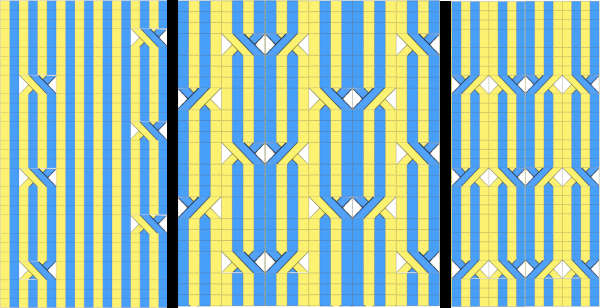 A variation doubling the width of the cable crossing in a half-drop repeat
A variation doubling the width of the cable crossing in a half-drop repeat 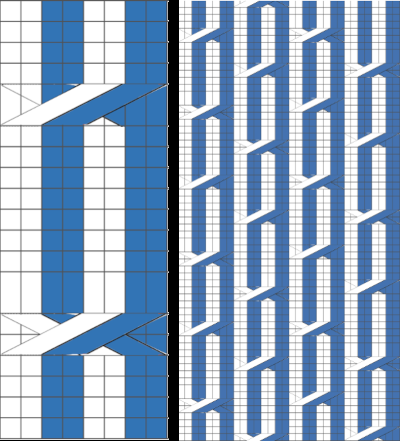 In machine knitting, one is looking at the purl side, and the ability to move stitches is often limited by the fact that their placement on a metal bed is fixed distances apart. Simpler repeats can be executed as isolated vertical bands on solid color or striped or even FI grounds, adding the ribber for even more complexity in execution.
In machine knitting, one is looking at the purl side, and the ability to move stitches is often limited by the fact that their placement on a metal bed is fixed distances apart. Simpler repeats can be executed as isolated vertical bands on solid color or striped or even FI grounds, adding the ribber for even more complexity in execution.
Hand knitting makes moving multiple stitches possible more easily, and because the crossings are usually made with the knit side facing, it remains easier to keep track of directions in which to move the stitches.
There are other choices in charting for either, cable crossings happen as a row progresses in hand-knit, and in machine knitting, knitting stops, and crossings are made before continuing with the next row. If color changes are planned every two rows then cables need to have multiples of 4 rows between each set of crossings. Hand-knit possibility on the left, with expanded charting for machine knitting  I continue to be fond of visualizing results in color in a spreadsheet prior to knitting swatches. As usual, as the sample charts multiply, the techniques often evolve as well for creating them.
I continue to be fond of visualizing results in color in a spreadsheet prior to knitting swatches. As usual, as the sample charts multiply, the techniques often evolve as well for creating them.
Without access to Excel, I am presently using Numbers 11.2 in macOS Monterey 12.0.1, a version with several changes from the previous. Working with shapes does not remain my preferred method, but shapes are useful and worth considering in drafts of charts for many stitch patterns outside this topic.
Notes on my process: to start with, a table is created with enough cells to accommodate more than one repeat of the planned cable crossings in both height and width. I prefer working on a cell size of 20X20 pixels and using magnification if needed to make work details more visible, decreasing it before screengrabs for illustrations here.
The choices for cell border styles may be made both in terms of colors and line quality or eliminated altogether 
 To add a shape, in the toolbar, search for shapes and select a category on the left,
To add a shape, in the toolbar, search for shapes and select a category on the left, 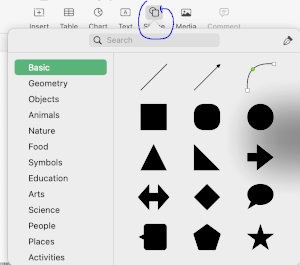 then click on the shape or drag one onto the sheet to add it.
then click on the shape or drag one onto the sheet to add it.
To browse all shapes move the pointer over the shapes pane and scroll down.
It is possible to create and save custom shapes.
To make a shape editable
1: click on a shape to select it
2: choose Format, Shapes and Lines, Make Editable from the format menu at the top of your screen,  handles will appear. In this case, a red square in each corner, and a small circle on the left side
handles will appear. In this case, a red square in each corner, and a small circle on the left side  3: double click a white handle to change the line from curved to straight, handles represent different types of lines
3: double click a white handle to change the line from curved to straight, handles represent different types of lines
Squares with a red outline: lines that connect to this point are straight
Circles with a red outline: lines that connect to this point are curved
4: click outside the edge of the shape when done editing it
Saving custom shapes
1: Click a custom shape to select it, then choose Format, Shapes and Lines, Save to My Shapes (from the Format menu at the top of your screen). 
 The shape is saved in the My Shapes category of the shapes library, which appears only when you have custom shapes. Shapes appear in the library in the order you create them, this order cannot be changed.
The shape is saved in the My Shapes category of the shapes library, which appears only when you have custom shapes. Shapes appear in the library in the order you create them, this order cannot be changed.
2. Type a name for the shape in the field that appears below it, or click the name to change it.
To delete a custom shape, Control-click it in the shapes library, then choose Delete Shape.
Color choices are the same as for any work with colored cells, for the default palette, left-click on the marked area, and choose from current fill selections 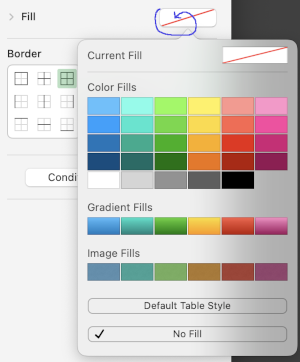 Choosing custom colors: left-click on fill, then on the colored globe, new selections appear, click on any one of the pencils to select the new color, it will move up from other selections, the change will be reflected, can be undone and repeated several times
Choosing custom colors: left-click on fill, then on the colored globe, new selections appear, click on any one of the pencils to select the new color, it will move up from other selections, the change will be reflected, can be undone and repeated several times  Creating the first cable crossing shape: choose the square from the basic shapes, if the first plan is to work across 3 cells, change its size to the width of 60 pixels, 20X3, and single height of 20 pixels, also changing colors if desired. To do so, left-click on it, uncheck constrain proportions, and change values to desired ones
Creating the first cable crossing shape: choose the square from the basic shapes, if the first plan is to work across 3 cells, change its size to the width of 60 pixels, 20X3, and single height of 20 pixels, also changing colors if desired. To do so, left-click on it, uncheck constrain proportions, and change values to desired ones 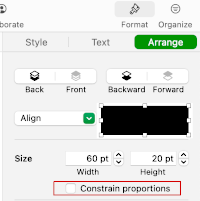 Change its color
Change its color  It is a good idea to copy and paste a few shapes outside the table in case they are needed
It is a good idea to copy and paste a few shapes outside the table in case they are needed
A: place the shape on the cell grid
B: make the shape editable
C: click on the left upper corner of the shape on the small white square, it will turn red, drag, and place it where desired, and release it
D: repeat with the small white square in the lower right corner, release
E: check image size, adjust to 60 pixels wide, 20 high, make editable again if tweaking is needed,
F: the first crossing shape is completed  Right-click on the final shape, copy it, and paste it several times on the sheet away from the table.
Right-click on the final shape, copy it, and paste it several times on the sheet away from the table.
Copying and pasting shapes on a single cell will fit any image within its borders, to remove it choose the cell, color fill, no fill, from the format menu 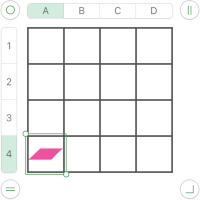 To use the shape, left-click on it, drag it into the desired position.
To use the shape, left-click on it, drag it into the desired position.
Cable crossings are usually in pairs, so a companion shape will be needed, 60 pixels wide by 20 high, in a contrasting color, the results of making the larger image editable

 The combined images may be created in a paint program such as Gimp and the resulting file, in turn, may be used in a spreadsheet. Pngs can be custom filled with any color of your choice in Gimp or its equivalent
The combined images may be created in a paint program such as Gimp and the resulting file, in turn, may be used in a spreadsheet. Pngs can be custom filled with any color of your choice in Gimp or its equivalent ![]()
![]()
![]()
![]() To draw a straight line in Gimp when applicable, select your preferred brush tool, click the point that begins your line, hold the Shift and Command keys in a Mac, drag the cursor to where you want the line to end. Click the endpoint, this creates a straight line between the two points with your selected brush. After the line is drawn, release the Shift and Command keys.
To draw a straight line in Gimp when applicable, select your preferred brush tool, click the point that begins your line, hold the Shift and Command keys in a Mac, drag the cursor to where you want the line to end. Click the endpoint, this creates a straight line between the two points with your selected brush. After the line is drawn, release the Shift and Command keys.
When charts are for personal use only, individual preference guides visualization methods, considerations for publishing may be different.
Yarn colors may be used in the charts, moving wider columns of stitches may be difficult if not impossible on a machine, but hand knitting opens a different world of opportunities for pattern use.
Working in a spreadsheet is easier for me than only using Gimp.
Seeking out a method for better definition of cable stitches to facilitate following crossings visually, cable crossing rows here are now double-height for added clarity; other choices include showing grid or not, and using BW for stitches crossed to the front in any direction.
Disregarding the grid, each column of color could be any number of stitches wide, while having the grid allows for easy counting of rows. Any chart may be used in knitting using a single color as well. 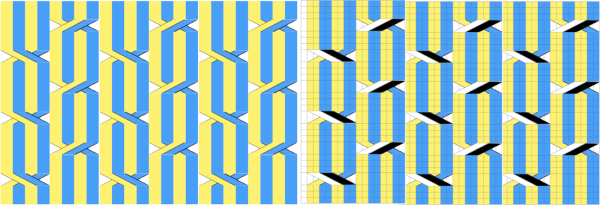 Fair isle repeats: when working cables in FI, in addition to tracking cable directions, the needles must be placed in the proper needle positions B and D for correct patterning to continue.
Fair isle repeats: when working cables in FI, in addition to tracking cable directions, the needles must be placed in the proper needle positions B and D for correct patterning to continue.
A series of cables executed along vertical lines of the same color. The red border surrounds the full repeat. These illustrations are as they would appear for hand knitting, with crossings made as knitting progresses along the corresponding chart rows on the knit side of the fabric 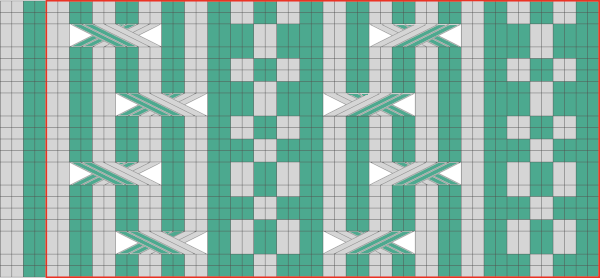 Fair isle on mixed striped ground
Fair isle on mixed striped ground 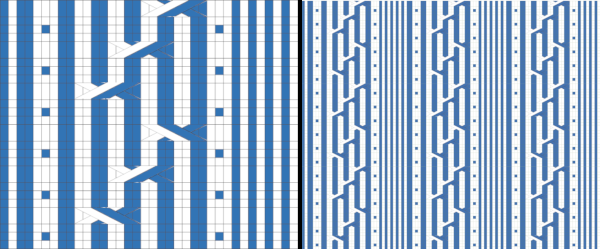 Fair isle with repeat changes, expanded further by mirroring
Fair isle with repeat changes, expanded further by mirroring 

 An expanded MK illustration
An expanded MK illustration 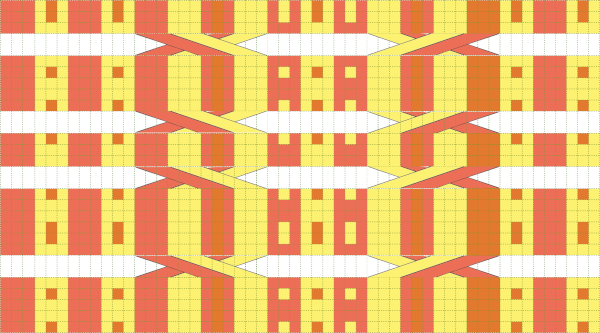 A FI sample shared in 2015.
A FI sample shared in 2015.  From Slip stitch patterns with hand transferred stitches, single bed 2/21
From Slip stitch patterns with hand transferred stitches, single bed 2/21
 When using fair isle patterning as a guide to forming cables on the machine, crossing directions matter more since one is no longer simply placing color on like color: this chart transitions from the original idea to the placement of the crossings, a full repeat with their direction reversed based on which color is wanted to travel to the knit side is drawn, and on the far right, the look of the final FI repeat
When using fair isle patterning as a guide to forming cables on the machine, crossing directions matter more since one is no longer simply placing color on like color: this chart transitions from the original idea to the placement of the crossings, a full repeat with their direction reversed based on which color is wanted to travel to the knit side is drawn, and on the far right, the look of the final FI repeat 
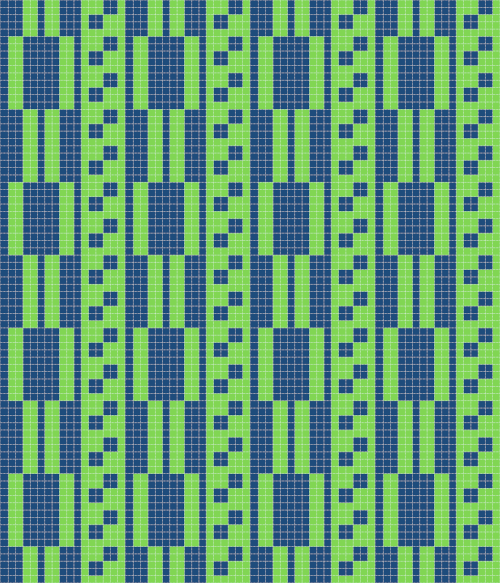 Adding a third color, possible intarsia knit as all over pattern or isolated as a panel. Even in hand-knit, the latter may be in a contrasting gauge and joined to pieces of the garment after their completion.
Adding a third color, possible intarsia knit as all over pattern or isolated as a panel. Even in hand-knit, the latter may be in a contrasting gauge and joined to pieces of the garment after their completion. 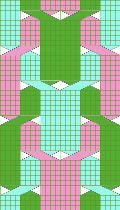

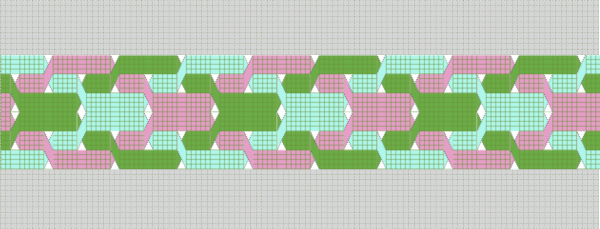 These repeats may be worked as vertical panels between rows of plain knit or rib
These repeats may be worked as vertical panels between rows of plain knit or rib 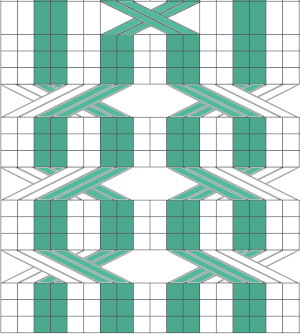
 Symmetry is not always needed,
Symmetry is not always needed, 
 MK, adding the ribber: one of the things that may lead to confusion is the use of the term every other needle knitting. If one is working on every needle on both beds, the needles on either bed are centered between those on the opposite one, thus patterning occurring on either bed that becomes EON. Colors are used to track the movement of stitches, not colorwork, which happens on the same needles, either bed, or the plaiting feeder may be used to produce the illusion of additional colors.
MK, adding the ribber: one of the things that may lead to confusion is the use of the term every other needle knitting. If one is working on every needle on both beds, the needles on either bed are centered between those on the opposite one, thus patterning occurring on either bed that becomes EON. Colors are used to track the movement of stitches, not colorwork, which happens on the same needles, either bed, or the plaiting feeder may be used to produce the illusion of additional colors. 
 Part of an experimental swatch using the ribber and tuck settings
Part of an experimental swatch using the ribber and tuck settings 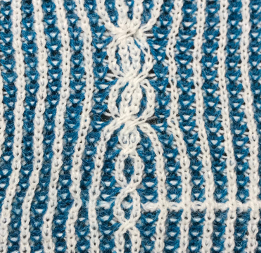 In attempting brioche on the machine the color changes happen every 2 rows, so a minimum of 4 rows or a multiple of 4 rows are planned between moving any stitches. Although the same color will be used in the crossings each time, using 2 colors for cable segments may make the chart easier to follow
In attempting brioche on the machine the color changes happen every 2 rows, so a minimum of 4 rows or a multiple of 4 rows are planned between moving any stitches. Although the same color will be used in the crossings each time, using 2 colors for cable segments may make the chart easier to follow 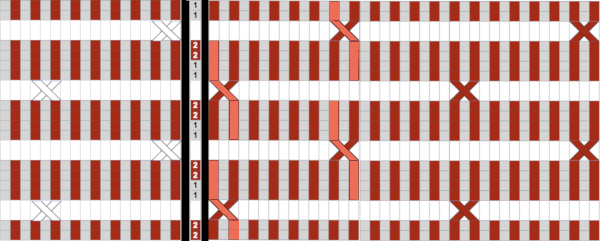 Using the ribber, one of the crossings on striped grounds: Slip stitch patterns with hand transferred stitches, double bed. 2/21
Using the ribber, one of the crossings on striped grounds: Slip stitch patterns with hand transferred stitches, double bed. 2/21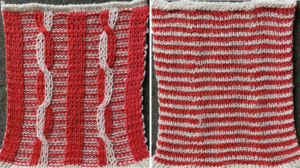
 A range of experiments with associated samples:
A range of experiments with associated samples:
Some cables to try, hand-knit 1/15
A hand-knit stitch tale 2: a bit of cables and lace, charting, HK to MK 7/14
Chain cable HK experiment 1/13
Machine knitting cables: single bed, 1 12/14
Machine knitting cables: single bed, introducing the ribber 1/15
Some “real” cables on KM 1/12
Hand to machine, symbols 4: cables 2/13
A simple braided cable (and card) 1/12
Machine knit cables: using patterning as a guide to transfers 2/15
Using punchcards to track cables and twists in pattern 2 12/11
Using punchcards to track small cables in pattern 1 1/12
Holding and “cables” 12/11
Pretend/ mock cables 4: revisiting i-cords 1/13
Pretend/ mock cables 3 7/18
Pretend/ mock cables 2 1/14
Pretend/ mock cables 1: i-cords, holding 1/12
A few i-cords and more to try 1/12
Cables with lace transfers 12/11
Cables in color 2/15
Visualizing knit cables in color_ Excel 1/15
Knit charting in Mac Yosemite; visualizing knit cables 11/14
Machine or hand knit symbols DIY charts with copy and paste in Gimp
Over the years I have accumulated different knitting fonts, some not now compatible with Mac OS 12 or long since unavailable, while others are from encounters with less common fonts, Webdings, and Windings, or self hand-drawn.
Knitters interested in creating simple charts with no access to spreadsheets or with symbol-producing design software, but with some familiarity with photo editors such as in this case Gimp, may find this an alternative way to produce knitting charts, working on large grid units to start with or with magnification.
This first image is 12 cells wide, and 28 high, composed originally in my spreadsheet program, Mac Numbers, using cells 50 pixels wide and high, the final table image was screen grabbed and opened in Gimp, it is rotated here for sake of space. To use it, click on the image, a larger scale version will open in a different window, save that image by whatever means you prefer, and open it or copy and paste it in Gimp. Use image, transform, to rotate 90 degrees clockwise to change its orientation to upright, check scale, adjust slightly if needed before continuing, it should measure 600 pixels in width by 1400 in height,  A grid of 50 pixels in width and height for the image can be configured and shown on top of the image to check the size and placement of the symbols.
A grid of 50 pixels in width and height for the image can be configured and shown on top of the image to check the size and placement of the symbols.  It is hidden in the original, the finer grid lines are used as guides for isolating the symbols that will be used in your chart.
It is hidden in the original, the finer grid lines are used as guides for isolating the symbols that will be used in your chart.
Choose file new, retain the same size, and configure its grid to 50X50 pixels. At that point, the image may be trimmed to a smaller number of units to accommodate your repeat. Navigating between the two screens, use the rectangle tool to select symbols you wish to use in your chart, copy and paste them into the new image in the center of the appropriate cells.  Another option if lots of symbols are to be used repeatedly is to copy each into a part of the new image that will not be a part of the final chart once, and then repeated copy and paste can happen from there on the single screen
Another option if lots of symbols are to be used repeatedly is to copy each into a part of the new image that will not be a part of the final chart once, and then repeated copy and paste can happen from there on the single screen 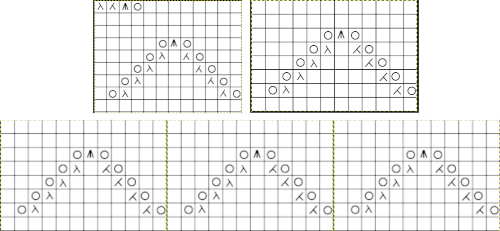 For more on grids and guides see Gimp update for Mac 2.
For more on grids and guides see Gimp update for Mac 2.
The image for use with a 26-pixel design grid when rotated it will measure 312 pixels in width, 728 pixels in height, ![]() A few cable samples, the file is 390 pixels wide by 286 high on 26-pixel cells, not all these cables are executable on the machine, extra yarn lengths would be required to allow stitches to move over far enough on the metal bed for the next row to form knit stitches properly,
A few cable samples, the file is 390 pixels wide by 286 high on 26-pixel cells, not all these cables are executable on the machine, extra yarn lengths would be required to allow stitches to move over far enough on the metal bed for the next row to form knit stitches properly, 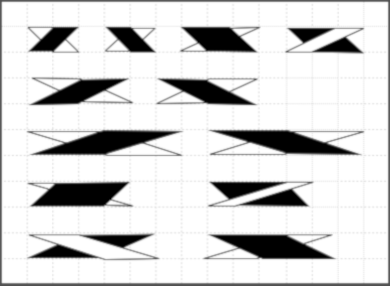 A sample cable with knit columns added to each side, colors, more symbols, and widths of repeats can all be adjusted. If the images are saved in the full size as pngs, the grids are lost. To retain the grid, the image needs to be screengrabbed and in turn rescaled to the desired size.
A sample cable with knit columns added to each side, colors, more symbols, and widths of repeats can all be adjusted. If the images are saved in the full size as pngs, the grids are lost. To retain the grid, the image needs to be screengrabbed and in turn rescaled to the desired size.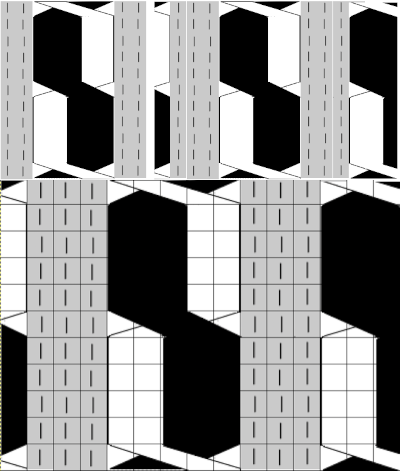 more copy and paste to visualize a larger repeat
more copy and paste to visualize a larger repeat  An added note on Gimp: my blog posts are now created on an iMac with OS12 and M1 chip. Rosetta needed to be installed for the program to run. I have found some issues with the pencil tool not working at all or properly or commands no longer working after several steps. Quitting the program did not eliminate the problem. What appears to solve the issue is to go to Preferences Folders, and then to choose the reset brush folder command.
An added note on Gimp: my blog posts are now created on an iMac with OS12 and M1 chip. Rosetta needed to be installed for the program to run. I have found some issues with the pencil tool not working at all or properly or commands no longer working after several steps. Quitting the program did not eliminate the problem. What appears to solve the issue is to go to Preferences Folders, and then to choose the reset brush folder command.  Of course, since the program is a new install, my previous collection of custom brushes will need to be recreated.
Of course, since the program is a new install, my previous collection of custom brushes will need to be recreated.
For an extensive collection of knitting symbols and their meanings, inspiration for adding your own as needed, see http://www.knittingfool.com/Reference/KF_Symbols.aspx
Machine knit leaves using slip stitch with holding
In 2012 I had a sort of leaf obsession, which led to my exploring a range of shapes created in both hand and machine knitting, including a series of shawls that were machine knit, using the lace carriage, intended for both gifts and sale.
Online resources were not as abundant back then, searches are more productive now via browser searches, pinboards, and Ravelry.
I have always been interested in holding techniques and automating them on both punchcard and electronic machines. In recently revisiting shell shapes I was reminded of leaves once more and thought I would return to working with them.
An early abandoned effort in trying to construct leaf shapes automating their shaping using holding in combination with slip stitch followed other earlier posts is shown below. In all honesty, I have been blogging long enough so I often do not recall previous writings on a recent spark of interest and execute a personal version of reinventing the wheel, starting from scratch, or executed poor note-keeping which in turn requires it.
A variety of lozenge and “leaf”-shaped forms may be found in previous posts on holding intarsia, some are strictly hand-selected, others are automated. There is a series of 5:
2016/06/21/a-bit-of-holding-1/
2016/06/29/a-bit-of-holding-2-moving-shapes-around/
2016/07/12/a-bit-of-holding-3-shape-variations-and-more/
2016/07/24/a-bit-of-holding-4-intarsia-and-more/
/2016/08/13/a-bit-of-holding-5-intarsia-and-more-2/
Checking the repeat for a single shape  Adding a second color and reversing directions of shapes brings lots of yarn ends and its “price to pay”
Adding a second color and reversing directions of shapes brings lots of yarn ends and its “price to pay”
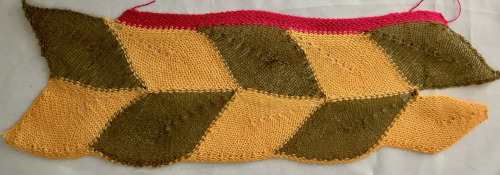
 Some handknit large scale inspiration to begin my revisit to MKing them: Garnstudio 1
Some handknit large scale inspiration to begin my revisit to MKing them: Garnstudio 1  and Garnstudio 2, which introduces lace transfer stripes between leaf forms
and Garnstudio 2, which introduces lace transfer stripes between leaf forms  A free hand knitting pattern, “Papagena“, that takes similar shapes to a triangular layout for shawl shaping
A free hand knitting pattern, “Papagena“, that takes similar shapes to a triangular layout for shawl shaping  Stitch Maps is an online source for hand knitters with interesting graphics that include some for held shapes, such as this
Stitch Maps is an online source for hand knitters with interesting graphics that include some for held shapes, such as this  The chart is actually rotated 90 degrees counterclockwise, could serve as inspiration for an electronic pattern.
The chart is actually rotated 90 degrees counterclockwise, could serve as inspiration for an electronic pattern.
Returning to a possible far smaller repeat that may be executable on a punchcard machine as well. The central vein in the forms is created by having held stitches with no wraps along and up to its center in height, creating 2 continuous shapes that mirror horizontally and repeat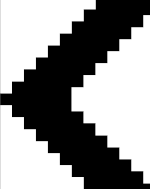 Automated holding sequences may be planned for single or multiple stitches in width, as well as for single and multiple rows in height. For the new initial test, which proved to need editing, this was my repeat
Automated holding sequences may be planned for single or multiple stitches in width, as well as for single and multiple rows in height. For the new initial test, which proved to need editing, this was my repeat A tiny test in too thin a yarn
A tiny test in too thin a yarn  I am knitting on a 930, the image needs to be mirrored in order for it to appear in the direction I intend on the knit side. The above repeat did not work properly when knitting a whole row of shapes. With some patience, a final, edited, and mirrored repeat was developed that enabled a completed a full row of shapes using the slip setting and holding, and starting with working it from right to left. Sometimes differences are subtle, especially in designing using single-pixel units. The new repeat proved to also work for rows of shapes in the reverse direction after horizontal mirroring and restarting the pattern or design row 1. When working from right to left, the initial preselection row is from left to right, while when working from left to right, the first preselection row is from right to left. After a full row of repeats is completed, the pattern is rolled back to row 1 and mirrored. Punchcard knitters could turn the card over and start again on the proper row. I used contrast color knit rows initially in between rows of shapes to help me note transitions more clearly. The “leaf” is not pointy enough for me, but at times what was not planned may lead to a pleasing result of a different sort.
I am knitting on a 930, the image needs to be mirrored in order for it to appear in the direction I intend on the knit side. The above repeat did not work properly when knitting a whole row of shapes. With some patience, a final, edited, and mirrored repeat was developed that enabled a completed a full row of shapes using the slip setting and holding, and starting with working it from right to left. Sometimes differences are subtle, especially in designing using single-pixel units. The new repeat proved to also work for rows of shapes in the reverse direction after horizontal mirroring and restarting the pattern or design row 1. When working from right to left, the initial preselection row is from left to right, while when working from left to right, the first preselection row is from right to left. After a full row of repeats is completed, the pattern is rolled back to row 1 and mirrored. Punchcard knitters could turn the card over and start again on the proper row. I used contrast color knit rows initially in between rows of shapes to help me note transitions more clearly. The “leaf” is not pointy enough for me, but at times what was not planned may lead to a pleasing result of a different sort.
The amended, corrected repeat is shown on the right 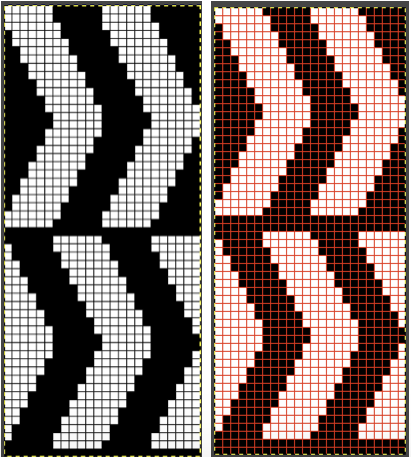
 To knit: cast on with a multiple of 12 stitches on each side of the center 24 on the needle bed
To knit: cast on with a multiple of 12 stitches on each side of the center 24 on the needle bed
Cancel end needle selection
COL: first preselection row from left to right
COR: set machine for both slip <– –> and hold
all needles will have been preselected, knitting every stitch, knit 2 rows, return to the right, as the row is knit, patterned preselection occurs
COR: bring all needles to the left of the first 12 on the right into hold position, knit until all needles in the group of 12 are preselected again, the carriage will be on the right
*COR: bring a group of 6 needles to the left of the 12 stitch group just completed into work, knit one row to left
COL: bring 6 stitches from the completed shape on the right to hold, continue in the pattern on the new 12 stitch group until all 12 stitches are once again preselected, stopping with COR***
repeat * to *** end working the full last group of 12 stitches on the left, including the last 12 stitch preselection
At the completion of a row of shapes COL: make a decision about the transition, whether any extra rows knit are a problem or not, and whether added rows in contrasting colors are wanted. To proceed with no changes in cam settings and 4 rows of knitting between the rows of shapes remembering that the first preselection row needs to be made from right to left.
COL: manually return all needles to upper work position (D). They will knit row 1 of the stripe
COR: manually push all needles to D again, return program to design row one, check settings, as the first design row pattern is preselected an all knit row 2 will be added. As patterning resumes from the left another 2 all knit rows will be produced before selective patterning occurs.
If any extra all knit rows are wanted cancel patterning on the knit carriage, set it to N, knit the extra rows, remember to end on the proper side for the first preselection row, and what options may be necessary to complete that row correctly.
To reverse patterns without extra knit rows:
COL: store yarn. The carriage can be removed and brought to the opposite side, or stitches need to be manually be placed in the B position for a free pass to the right. This involves placing the cam selector button on N, returning the cams set to slip in both directions.
COR, all needles also need to be in work in B position, no yarn, in order to make a free pass to preselect from right to left, ending COL
COL: pick up yarn and continue in pattern. These textures require a lot of carriage passes, which tend to fuzz up the yarn on the purl side of the knit a bit. The shape I created was not very leafy to my mind, but still interesting, especially on the purl side. The yarn used in a 2/15 wool, knit on Tension 5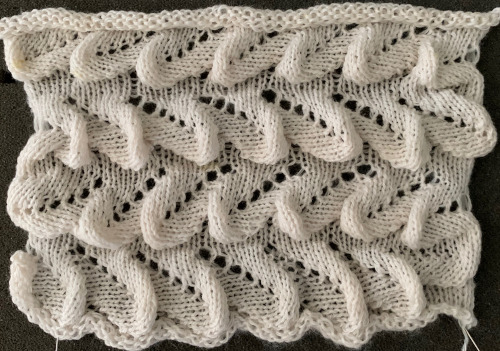
 Moving on to a wider version, using 24 stitches in width to allow for using the pattern on a punchcard: this repeats works both as-is and mirrored, the groups of stitches moved in and out of work is now half of the new design repeat = 12.
Moving on to a wider version, using 24 stitches in width to allow for using the pattern on a punchcard: this repeats works both as-is and mirrored, the groups of stitches moved in and out of work is now half of the new design repeat = 12.  Making the repeat work in any number for this shape involves lining up the needle selection in each group of needles and constant counts for holding sequences. Punchard knitters would need 2 separate cards.
Making the repeat work in any number for this shape involves lining up the needle selection in each group of needles and constant counts for holding sequences. Punchard knitters would need 2 separate cards. 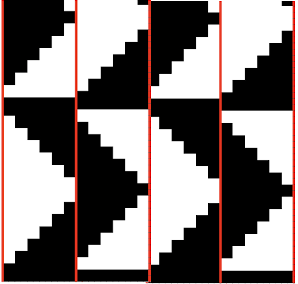 The lovely mess in the swatch happened when I stopped paying attention to everything but what was happening on the needle bed and missed the tangle of yarns in my yarn mast. There is enough knitting, however, to note that the repeat is sound and that the edges on both sides are formed by the narrowest part of the shapes in each direction. One way to solve that is by casting on and binding off along tops and bottoms of shapes as seen in the yellow and green swatch at the top of the post.
The lovely mess in the swatch happened when I stopped paying attention to everything but what was happening on the needle bed and missed the tangle of yarns in my yarn mast. There is enough knitting, however, to note that the repeat is sound and that the edges on both sides are formed by the narrowest part of the shapes in each direction. One way to solve that is by casting on and binding off along tops and bottoms of shapes as seen in the yellow and green swatch at the top of the post.  Planning things out to release those edges as seen at the top of the post
Planning things out to release those edges as seen at the top of the post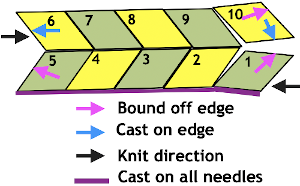
Working on outlining the shapes with contrast color: 
 Problems to solve: maintaining an even number of rows in-between shapes and a straight edge along both sides. The latter could happen with triangles prior to knitting full shapes at either or both ends, the first sample failed on the left side due to both triangles being knit in the same sequence;
Problems to solve: maintaining an even number of rows in-between shapes and a straight edge along both sides. The latter could happen with triangles prior to knitting full shapes at either or both ends, the first sample failed on the left side due to both triangles being knit in the same sequence; 
 that may be solved by beginning shaping on 2 stitches on the left rather than the full 12, mirrored. The proper sequence for actual knit stitches for the first, bottom set, and mirrored for the second, top set
that may be solved by beginning shaping on 2 stitches on the left rather than the full 12, mirrored. The proper sequence for actual knit stitches for the first, bottom set, and mirrored for the second, top set  still only partway there
still only partway there 
 I am presently knitting with my left hand in a splint that has exposed velcro teeth, which has caused some interesting issues with actual knitting and with yarn snags. To end this latest effort, in yet another knitting aaargh! moment, it appears my iron is now overheating and burned the wool! From observing the above swatch on the purl side it looks as though each row of shapes needs to have a triangular shape at each end. Also, the contrasting color line thickness is not constant. The purpose of automation should be to make things easier, not confounding. After yet another trial, I decided to give up on attempting to use the automated repeat to produce an effect that was consistent and made me happy.
I am presently knitting with my left hand in a splint that has exposed velcro teeth, which has caused some interesting issues with actual knitting and with yarn snags. To end this latest effort, in yet another knitting aaargh! moment, it appears my iron is now overheating and burned the wool! From observing the above swatch on the purl side it looks as though each row of shapes needs to have a triangular shape at each end. Also, the contrasting color line thickness is not constant. The purpose of automation should be to make things easier, not confounding. After yet another trial, I decided to give up on attempting to use the automated repeat to produce an effect that was consistent and made me happy.
Setup for a leaf in each color is far less fiddly and simpler to execute. A tentative layout and knitting sequence:
 Begin on waste yarn, decide on the color of the cast on, and any additional knit rows prior to beginning in the pattern. Each of the side triangles is shaped using manual holding techniques over 12 stitches. If starting on the right, the first preselection row needs to be made moving from left to right as above on the first 24 stitches. With knit carriage set to both slip in both directions and holding with COL make certain the first 24 stitches on the right in B position make a free pass to the right.
Begin on waste yarn, decide on the color of the cast on, and any additional knit rows prior to beginning in the pattern. Each of the side triangles is shaped using manual holding techniques over 12 stitches. If starting on the right, the first preselection row needs to be made moving from left to right as above on the first 24 stitches. With knit carriage set to both slip in both directions and holding with COL make certain the first 24 stitches on the right in B position make a free pass to the right.
COR: cut yarn, change color, knit the first shape repeat, end COR
COR: when all needles in the group are preselected, push the first 12 needles on the carriage side out to holding position, push 12 stitches on their left back into upper work position as you would in any holding pattern, they will knit in the slip setting as well. Cut the yarn, change color, repeat across the row of shapes
COR: when the last group of 12 needles on the left is preselected with all needles out to hold or removing the carriage and positioning it on the other side, begin knitting COL.
COL: manually knit triangle at top of the previous row of shapes
If a contrasting color stripe or any other pattern is intended between a full row of shapes, execute them and end COL
COL: shape the second triangle for the start of the reversed row of shapes, get the carriage to the right side by a pass over all needles in holding position or removing the carriage and bringing it to the opposite side
COR: the second pattern is programmed. Punchcard knitters use the second card, electronics mirror the shape. With the first 24 stitches on the left in B position and the knit carriage set for holding and to slip in both directions, make a preselection pass to left.
COL: change color, knit shape, and continue on as described above reversing shaping
As with intarsia, there will be lots of yarn ends to weave in and clean up those eyelets at the start of each color change. The swatch after a quick pressing

The possibilities could be endless. Electronic machines do not have the limitation of working within the 24 stitches maximum design width. Shapes can be fully automated using only slip stitch setting, no holding, but repeats become exponentially wide and long. The technique merits its own post.
A hand knit consult to machine knit slip stitch
I was contacted via a comment here about the possible methods for reproducing this handknit pattern  Observations: there are elongated loops on the knit side of the fabric, likely created with slipped stitches. There appear to be eyelets on the purl side. The total number of stitches remains constant throughout the knit. The row repeat spacing is fairly close, so at least to start with I tried single repeats to achieve the look, was not pleased with any of the initial results. That led me to an online search for what would visually appear to have similar qualities in handknit samples. Knittingfool.com is an extensive resource and, to my eye, this slip stitch pattern, “little birds”, shares similarities with the above swatch
Observations: there are elongated loops on the knit side of the fabric, likely created with slipped stitches. There appear to be eyelets on the purl side. The total number of stitches remains constant throughout the knit. The row repeat spacing is fairly close, so at least to start with I tried single repeats to achieve the look, was not pleased with any of the initial results. That led me to an online search for what would visually appear to have similar qualities in handknit samples. Knittingfool.com is an extensive resource and, to my eye, this slip stitch pattern, “little birds”, shares similarities with the above swatch  as do “oats” found in a 1984 handknitting publication
as do “oats” found in a 1984 handknitting publication 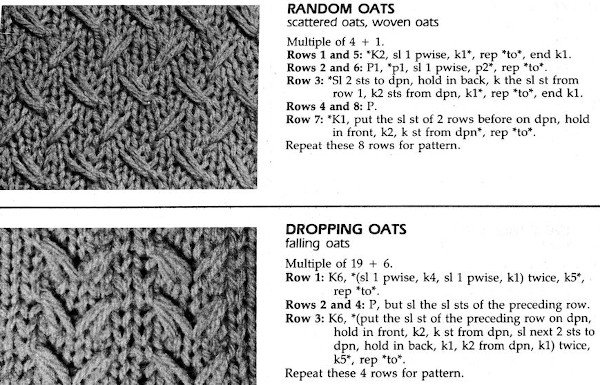 I have a hard time with longhand written instructions for patterns nowadays, have grown so used to creating or working from published charts. As usual, I plan out tentative repeats and ideas, began with this, toying with where to place slipped stitches
I have a hard time with longhand written instructions for patterns nowadays, have grown so used to creating or working from published charts. As usual, I plan out tentative repeats and ideas, began with this, toying with where to place slipped stitches 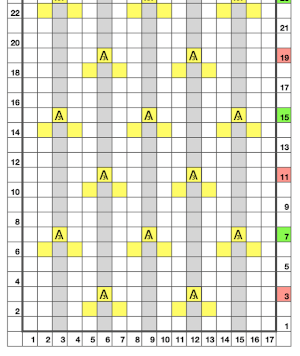 and then transitioned to translating any repeats for use in machine knitting, keeping in mind that in hand knitting actions are made as the row is being knit, while in machine knitting they take place prior to returning the carriage to the opposite side thus knitting that row. This was my first repeat after replacing cells with squares representing knit stitches with black and white planned pixels for electronic download.
and then transitioned to translating any repeats for use in machine knitting, keeping in mind that in hand knitting actions are made as the row is being knit, while in machine knitting they take place prior to returning the carriage to the opposite side thus knitting that row. This was my first repeat after replacing cells with squares representing knit stitches with black and white planned pixels for electronic download.
 On the machine, the distance between stitches is fixed, so for any crossings or lots of movement across the needle bed it is best to use yarn with a bit of stretch, and a stitch size large enough to allow for the desired actions. I found slipping for 2 rows only did not create enough loop length, so I changed the slip stitch areas to 3 rows in height.
On the machine, the distance between stitches is fixed, so for any crossings or lots of movement across the needle bed it is best to use yarn with a bit of stretch, and a stitch size large enough to allow for the desired actions. I found slipping for 2 rows only did not create enough loop length, so I changed the slip stitch areas to 3 rows in height. 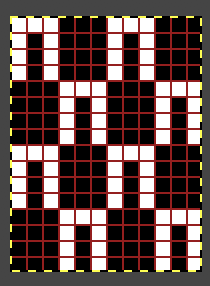 The slip stitch setting is used in both directions throughout. White squares represent areas where needles on the bed are skipped/slipped, not being selected forward and thus knit. This happens for 3 rows, resulting in the required elongated stitches. On the 4th pattern row, the group of 3 not selected needles is where the stitch transfers and crossings occur. Any cabling, eyelet fill-in, etc, needs to be performed prior to knitting that row and moving the carriage to the opposite side. The work is always done with purl side facing, so matching the direction of patterning to a hand-knit may also require mirroring of crossings, depending on your knitting machine model. The goal is to have the K3tog with the long loops in front of the single knit stitch in the center position.
The slip stitch setting is used in both directions throughout. White squares represent areas where needles on the bed are skipped/slipped, not being selected forward and thus knit. This happens for 3 rows, resulting in the required elongated stitches. On the 4th pattern row, the group of 3 not selected needles is where the stitch transfers and crossings occur. Any cabling, eyelet fill-in, etc, needs to be performed prior to knitting that row and moving the carriage to the opposite side. The work is always done with purl side facing, so matching the direction of patterning to a hand-knit may also require mirroring of crossings, depending on your knitting machine model. The goal is to have the K3tog with the long loops in front of the single knit stitch in the center position.
To execute the slip stitch crossings in front of the center knit stitch on the knit side of the fabric transfer the center stitch in the group of 3 and hold aside, take the left elongated stitch and move it onto the now empty needle at the center position of the group of 3 transfer the elongated stitch on the right onto that same center stitch. This may be done in the reverse order to have loops move in the opposite direction on the knit side of the fabric.
transfer the elongated stitch on the right onto that same center stitch. This may be done in the reverse order to have loops move in the opposite direction on the knit side of the fabric. 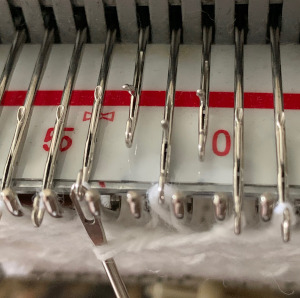 Move the stored original center stitch back onto that center position, there will now be 3 stitch loops held on the single needle
Move the stored original center stitch back onto that center position, there will now be 3 stitch loops held on the single needle 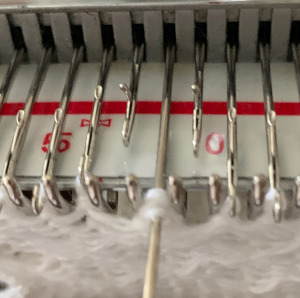 fill in the empty needles to avoid large eyelets, picking up from the row below
fill in the empty needles to avoid large eyelets, picking up from the row below 
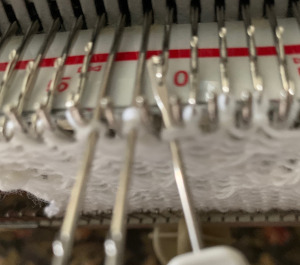
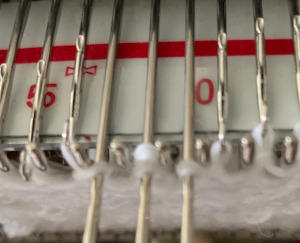 repeat the process across the bed, bring all the needles used out to hold position prior to knitting the next row
repeat the process across the bed, bring all the needles used out to hold position prior to knitting the next row 
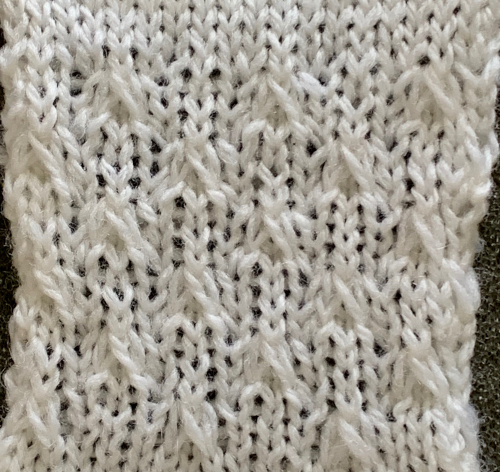
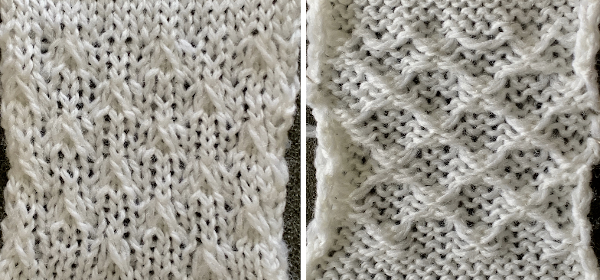 The yarn used was 3/8 wool at loosest tension possible, the result is subtle as any spaces between stitches get pretty well filled in. Moving on to denser patterning
The yarn used was 3/8 wool at loosest tension possible, the result is subtle as any spaces between stitches get pretty well filled in. Moving on to denser patterning 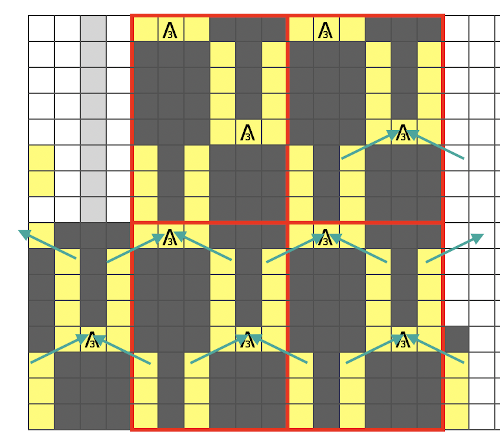
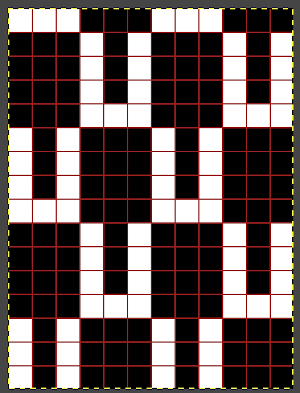 The elongated stitch crossings now happen every 4 rows, but across two needles, not one. I used a tightly twisted rayon for the test swatch thinking they might be more visible, but the openness in the stitch formation because of the fixed spacing on the metal bed confuses the texture a bit. Simply leaving the empty needle out of work and continuing to knit (1) created too large an eyelet to my taste. Trying to pick up the third slipped loop (2) had the same effect. The best result was obtained by picking up from the row below on each side of the three stitches that are removed and then returned to the needle bed (3).
The elongated stitch crossings now happen every 4 rows, but across two needles, not one. I used a tightly twisted rayon for the test swatch thinking they might be more visible, but the openness in the stitch formation because of the fixed spacing on the metal bed confuses the texture a bit. Simply leaving the empty needle out of work and continuing to knit (1) created too large an eyelet to my taste. Trying to pick up the third slipped loop (2) had the same effect. The best result was obtained by picking up from the row below on each side of the three stitches that are removed and then returned to the needle bed (3).
When pattern row 4 is reached, the not selected stitches are removed on a 3 prong tool, the elongated stitches are moved onto the center needle of the now resulting group of 5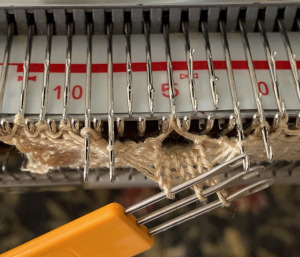 e wrapping the third row of floats can be tested by inserting a single eye tool front to back, twisting either counter or clockwise and rehanging on an empty needle, thus casting on an “extra” stitch
e wrapping the third row of floats can be tested by inserting a single eye tool front to back, twisting either counter or clockwise and rehanging on an empty needle, thus casting on an “extra” stitch 
 going back to picking up from row below
going back to picking up from row below  this shows the number of skip stitch floats in each test
this shows the number of skip stitch floats in each test  the appearance on the knit side
the appearance on the knit side  comparison to the handknit.
comparison to the handknit. 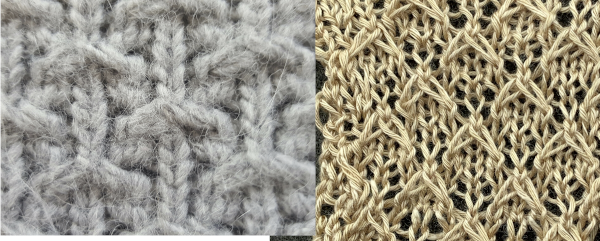 Charting the actions for a hand-knit version: the top images illustrate the moves on the purl side while on the machine, below it those on the knit side when hand knitting the pattern
Charting the actions for a hand-knit version: the top images illustrate the moves on the purl side while on the machine, below it those on the knit side when hand knitting the pattern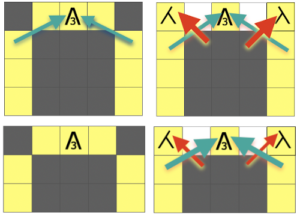 Plotting out borders and repeats for a small test including make-1 increases in order to keep the total stitch count constant. I do little hand knitting nowadays, so when doing so I add as much information as possible including some stitch counts until the pattern is established and I can visually follow it more easily.
Plotting out borders and repeats for a small test including make-1 increases in order to keep the total stitch count constant. I do little hand knitting nowadays, so when doing so I add as much information as possible including some stitch counts until the pattern is established and I can visually follow it more easily. 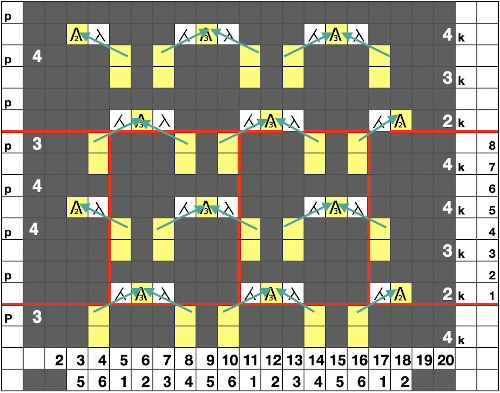 The resulting test swatch
The resulting test swatch 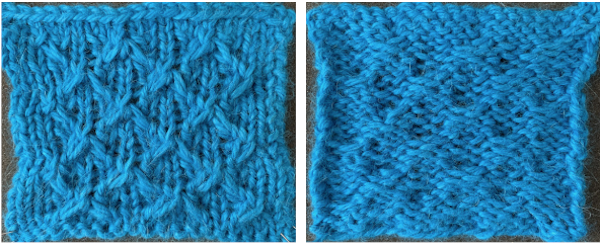 Comparison with the original: I knit 3 together through front loops, so my long stitches are crossed in the opposite direction of the original. Knitting through the back of the 3 stitches would reverse it and yield a matching result.
Comparison with the original: I knit 3 together through front loops, so my long stitches are crossed in the opposite direction of the original. Knitting through the back of the 3 stitches would reverse it and yield a matching result. 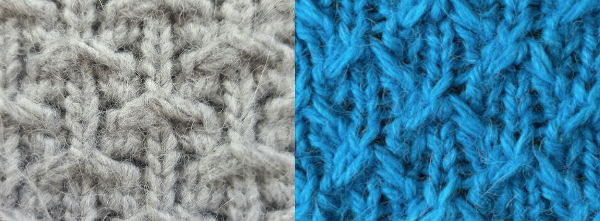 This is an illustration of the method I used to “make one”, in my swatch I kept the direction constant
This is an illustration of the method I used to “make one”, in my swatch I kept the direction constant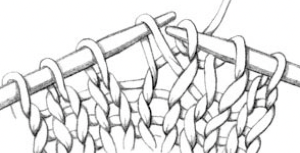
A later post that includes color explorations: Slip stitch patterns with hand transferred stitches, single bed
Revisiting automated shell shapes
My original posts on exploring automating shell shapes were written in my 910 electronic days using mylar sheets in early 2013: Thinking of modules: a shell “diary” “Automated” shell shapes
“Automated” shell shapes
 The repeat produced a visually successful fabric. I received a question on FB about executing the shells on a punchcard machine, and another on how I “come up with these things”. The repeats are not quick inventions, they take working out, sometimes through several first failed attempts.
The repeat produced a visually successful fabric. I received a question on FB about executing the shells on a punchcard machine, and another on how I “come up with these things”. The repeats are not quick inventions, they take working out, sometimes through several first failed attempts.
Since the early posts posts my approach to explanations has changed as I became increasingly familiar with newly available software and updates, and a 930 and img2track made downloading pngs possible in a new way.
iPhone cameras make it far easier to “shoot and share”.
My original mylar repeat entered as separate programs in days when each mylar sheet was precious. 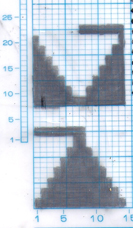 The 910 in my default setting produced the “image’ as drawn on the knit side of the resulting fabric. The post was written prior to my tiling the repeats as a matter of routine to check their alignments. Doing so would have shown a couple of missing pixels, and pointed to any other errors in filling in mylar squares.
The 910 in my default setting produced the “image’ as drawn on the knit side of the resulting fabric. The post was written prior to my tiling the repeats as a matter of routine to check their alignments. Doing so would have shown a couple of missing pixels, and pointed to any other errors in filling in mylar squares.
 All transfers were made in the same direction.
All transfers were made in the same direction.
The start of the visualizing the shell shapes with errors later observed and resolved.  As always, ideas need error-proofing and refining, easier done in a chart if possible prior to any actual knitting.
As always, ideas need error-proofing and refining, easier done in a chart if possible prior to any actual knitting.
This type of design begins to address an uninterrupted repeat on the electronic on a limited stitch count, whether all in a single direction or reversing every other full row of shapes. It is applicable to joining several punchcards, but only on single 24 stitch widths.
 There are a number of changes to make if it is necessary to get the pattern to reverse direction in alternate rows of completed shapes in a brick layout.
There are a number of changes to make if it is necessary to get the pattern to reverse direction in alternate rows of completed shapes in a brick layout.
My first tests were planned with knitting moving only from left to right. To execute such a pattern on a punchcard KM, the repeat needs to be altered from 14X2 to 12X2 in width. This is the start of sorting that out: Attempts to visualize holding can happen in spreadsheets, documents, image processing canvases, or even simply on graph paper, moving/ “drawing” back and forth across the cells mimicking carriage movements and marking them accordingly.
Attempts to visualize holding can happen in spreadsheets, documents, image processing canvases, or even simply on graph paper, moving/ “drawing” back and forth across the cells mimicking carriage movements and marking them accordingly.
Large staggered repeats can be programmed in electronic models
All shapes are limited in terms of the width of the repeat occurring across the number of available needles on any machine.
Some previous posts on electronic knitting such repeats:
Holding/short rows: hand tech to chart to automating with slip stitch 1
Ayab: short rows automated with slipstitch
A return to short row shapings: bumps and slits
The 910 produced the design as programmed on the knit side. On the punchcard machines, the image-as-drawn is produce on the purl side.
Lettering is likely the most familiar instance where mirroring is required for punchcard machines to produce it correctly, a consideration here as well. 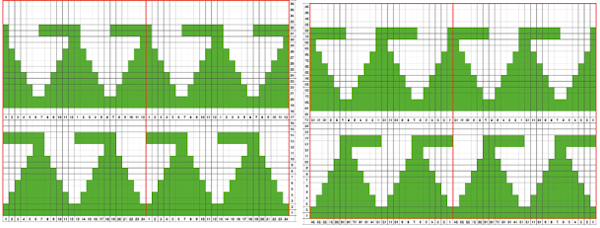 The 930 automatically mirrors downloaded motifs, if direction matters, as in these samples, either mirror the design horizontally prior to saving the png for download to the machine, or use the mirror button selection on the operation panel after the download.
The 930 automatically mirrors downloaded motifs, if direction matters, as in these samples, either mirror the design horizontally prior to saving the png for download to the machine, or use the mirror button selection on the operation panel after the download.
I find it easier to fill in the shapes in the direction I wish to have them appear on the knit side.
An attempt at a continuous 24 stitch repeat, with the same technique applicable to electronic models while avoiding programming 2 different repeats and having shapes in different colors across full repeat segments.
This proved to be a fail.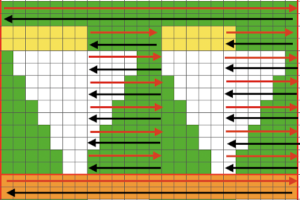
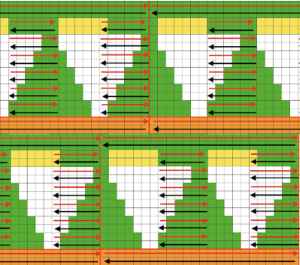 With larger gaps between changes, the yarn may be changed every X rows manually, making an easy fix to breaking rules for when using the color changer.
With larger gaps between changes, the yarn may be changed every X rows manually, making an easy fix to breaking rules for when using the color changer.
The next step is working out 12 stitch repeats with patterning needles to be brought in and out of holding position as well. The options on a punchcard would include 8, 12, and 24 stitch motif widths.
The machines will be set to slip in both directions throughout, end needle selection must be canceled. This method is not executable easily on km models that do not offer that option, electronics use KC II.
Note that machines sold in Europe in comparable models may have different names for the same functions, ie. SM in some instances is the equivalent of KC II, whereas in US it signifies a Single Motif.
Punchcard settings for end needle selection:  I do not have any blank punchcards to test a repeat on at the moment.
I do not have any blank punchcards to test a repeat on at the moment.
The 930 essentially behaves the same way by producing the entered pattern on the purl side, making it possible to use the unaltered final designs.
The starting 24 stitch brick repeat  Other shapes have previously been explored using slip stitch, and later, slip stitch combined with holding. A brief return to previous turns at holding and slip stitch used to create alternating color shapes: in 2013/02/12/an-entrelac-pretender/, a continuous slip stitch only card was used. The result on the knit side,
Other shapes have previously been explored using slip stitch, and later, slip stitch combined with holding. A brief return to previous turns at holding and slip stitch used to create alternating color shapes: in 2013/02/12/an-entrelac-pretender/, a continuous slip stitch only card was used. The result on the knit side, while on the reverse floats between alternating shapes are the norm
while on the reverse floats between alternating shapes are the norm 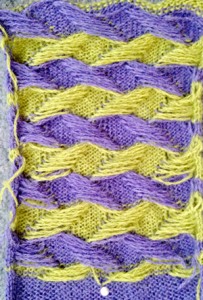 Results with no floats are found in the swatches in the posts, two designs are programmed alternately upon completion of each full row of shapes : 2013/02/21/entrelac-pretender-2/
Results with no floats are found in the swatches in the posts, two designs are programmed alternately upon completion of each full row of shapes : 2013/02/21/entrelac-pretender-2/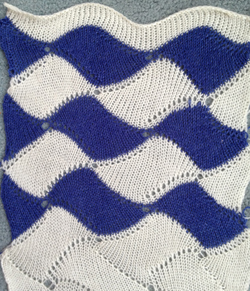 and a larger, 24 stitch motif used on a punchchard machine as a continuous repeat : 2013/04/11/entrelac-pretender-3/
and a larger, 24 stitch motif used on a punchchard machine as a continuous repeat : 2013/04/11/entrelac-pretender-3/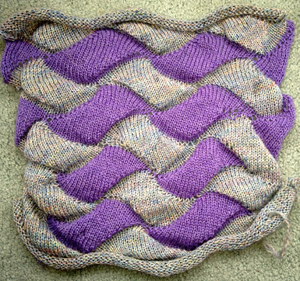
Returning to the goal of the moment: to knit the shells in a float-less way, using a technique executable on a punchcard machine as well. The repeat as initially drawn is 28 rows high.
If the punchcard or the electronic advance every row with each pass of the carriage, the alternating shifting blocks of the repeat will be selected in full with every 28 passes.
In this instance, one returns to the start of the design repeat every 28 rows. Identical shell full shapes are created across the knitting rather than the shifting shapes desired in alternating full row repeats.
Separating the 28-row repeat into 2-14 row ones.
The 12 stitch repeat is tiled X2 horizontally, beginning with a half shape, 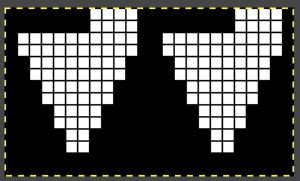 while here the repeat for all full-size shells is planned,
while here the repeat for all full-size shells is planned, 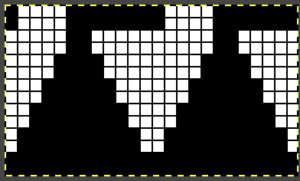 Marking up the needle bed with water-soluble markers or pencils helps track placements of repeats across the desired number of needles in work: dark lines indicate placement beginning with the mark for half a repeat to maintain straight side edges on the finished piece. Red lines mark the placement of the stitches when they are moved to the left in order to knit the full shells across the bed.
Marking up the needle bed with water-soluble markers or pencils helps track placements of repeats across the desired number of needles in work: dark lines indicate placement beginning with the mark for half a repeat to maintain straight side edges on the finished piece. Red lines mark the placement of the stitches when they are moved to the left in order to knit the full shells across the bed.  On a 930, the image will be knit in the direction of the pattern as drawn on the knit side, as it would be on a punchcard machine.
On a 930, the image will be knit in the direction of the pattern as drawn on the knit side, as it would be on a punchcard machine.
To begin knitting the shells with COR, since the pattern is fixed on the needle bed, one option is to move the work in one direction or the other on the needle bed using a garter bar, so that the knitting is in the proper place for the desired anticipated needle selection. This was easier in my own mind than reprogramming the pattern repeat for each full row of shells whether by entering a new download or altering placement using the position option at the start of each row. One of my first working repeats amended later in several steps is shown here mirrored in black and white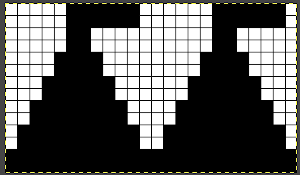 Visualizing the process on the needle bed
Visualizing the process on the needle bed
 Scaling the image to render it a bit more legible:
Scaling the image to render it a bit more legible: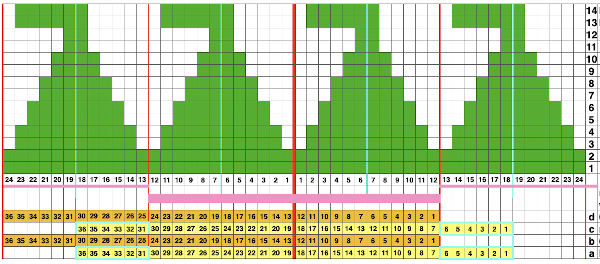
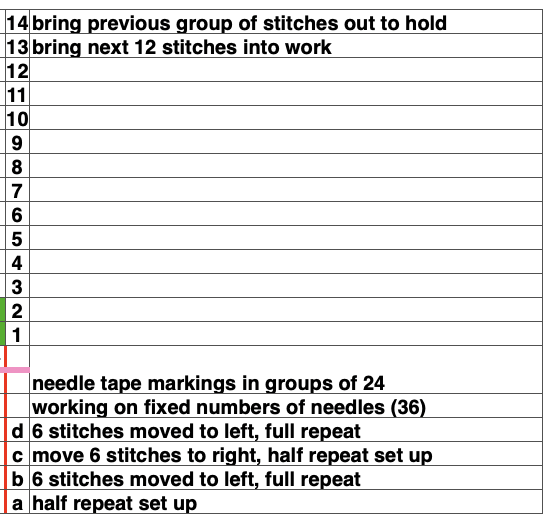 The machine will be set for slip stitch in both directions and holding. End needle selection is canceled.
The machine will be set for slip stitch in both directions and holding. End needle selection is canceled.
The first preselection row is from left to right. Every needle will be preselected and will knit every stitch for the first 2 rows in the desired shell color.
Color changes are made manually.
At the completion of a row of shells, its corresponding color ends on the left side, a free pass is made, returning to the right. Knitting with the new color for the alternate groups of shells begins again on the right side.
After the first 2 all knit rows, as the carriage works its way back to the right on the following pass, preselecting will occur for a decreasing number of stitches. This is the first-row holding selection when using the above repeat:
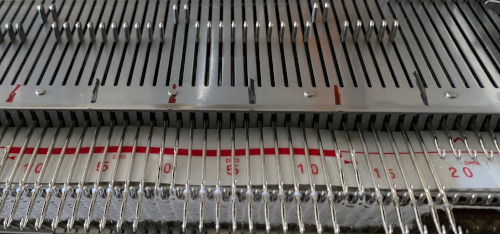

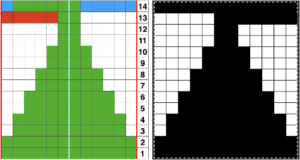 Moving stitches on the needle bed avoids having to program separate repeats after each full stripe of shells.
Moving stitches on the needle bed avoids having to program separate repeats after each full stripe of shells.
Beginning piece with half a shell on each side: all but the first 6 stitches are brought out to hold. When more than the single needle is selected at the top of the first half-shell (6 sts to start, 1 at the end), COR: bring the next group of 12 stitches to the left into work, knit to left.
COL: bring original 6 needles out to hold. Bring into work any needles not selected in the group of 12 into work as well.
Continue knitting, repeating the process across the bed.
On design row 14 of the last half-shell remove work on a garter bar.
To execute full shells across the next row of shapes: using a garter bar move the work 6 stitches to the left.
Return emptied needles to A position (out of work, OOW).
With all remaining needles in B preselect the next row (1) from left to right. Cam settings need not be changed.
Change color if desired, knitting 2 rows across all the stitches.
Bring all needles out to hold except for the first group of 12 sts between red marks, and repeat the process previously described across the bed.
When the last shell is completed, design row 14, remove the work on the garter bar again, shift it 6 stitches to the right.
Push back the now emptied needles back to A (OOW).
With all stitches in the B position, make a free pass to the right, row 1 of the half shell row will be preselected, change color, continue across the pattern row as described. This yarn is far too thin but makes stitch formation easy to identify. I used two repeats side by side to eliminate having to consider and choose the position option on the 930 needle bed, resulting in having the pattern centered in each 24 stitch fixed segment of needle selection.
I used two repeats side by side to eliminate having to consider and choose the position option on the 930 needle bed, resulting in having the pattern centered in each 24 stitch fixed segment of needle selection.
Using a needle tape for punchcard machines electronic models make transitions when using published or DIY 24 stitch designs.
It is possible to add all knit rows or even patterned ones between shell rows. On an electronic KM with 2 carriages available, adding a FI band would be simpler than trying to manage to change cam buttons in addition to the other number of steps already involved with the slip stitch and holding combination along with moving the knit on the needle bed.
Contrasting color row stripes can be programmed by adding 2 or more/ even number rows of all black squares (or punched holes) at the top of each 14-row segment of the final repeat. Reverse shaping of shells appears to not be necessary to avoid biasing on my limited tests. The proof of concept swatch: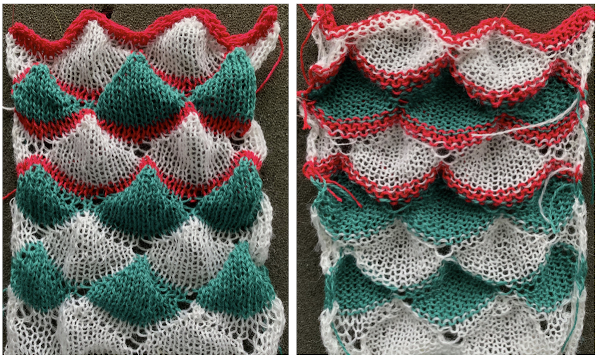 I was too aggressive with clipping yarn ends on the left side, especially while in the process of changing colors, not ever a good idea. Automating the pattern fully on electronic models using only slip stitch patterning is possible. The length of such patterns grows exponentially in proportion to the size of the repeats. Reviewing errors in the beginning concept
I was too aggressive with clipping yarn ends on the left side, especially while in the process of changing colors, not ever a good idea. Automating the pattern fully on electronic models using only slip stitch patterning is possible. The length of such patterns grows exponentially in proportion to the size of the repeats. Reviewing errors in the beginning concept 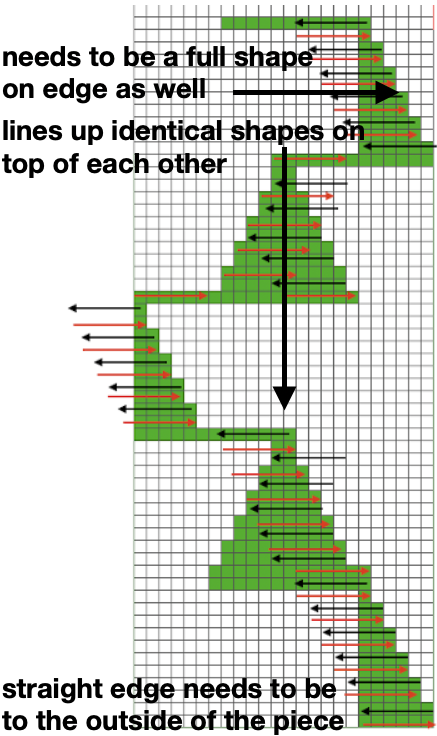 An attempt to visualize the placement of the shape variations in the finished piece using the shell motifs beginning with the shapes created in order to create a straight side edge
An attempt to visualize the placement of the shape variations in the finished piece using the shell motifs beginning with the shapes created in order to create a straight side edge
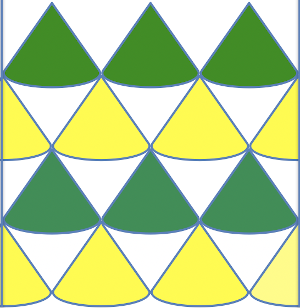
Redrawing the pattern for a 36 stitch test. On the left is the drawn image of the pattern, on the right the mirrored image for downloading to my machine to produce it in the desired direction. Much of the time is invested in developing and testing the final and correct image for download, the knitting that follows that is fairly quick. My repeat is 36 stitches wide, 98 rows high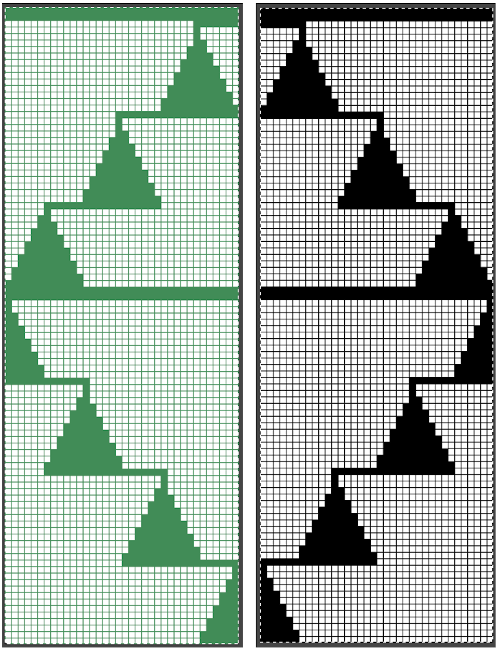 COR: knit a base row in color one from right to left
COR: knit a base row in color one from right to left
COL: KCII (no end needle selection) to right, the only needles preselected will be those corresponding to the programmed black squares, the remaining will be in B position. Knit to the right.
COR: set the machine to slip in both directions. Knit slowly and evenly. All needles in work on the bed must be cleared with each pass of the carriage.
Continue in pattern across the bed, checking that all stitches are knitting off properly.
When all needles are preselected, change colors for the next set of shells. These rows create the base for the next group of shapes. If a stripe or other pattern is wanted regularly, those rows are best added to the programmed pattern itself.
The automated test swatch:  Preserving the 3D texture relies on using yarns with “memory”, ie wool and avoiding aggressive blocking. Using thinner yarns makes the stitch formation more evident. Hard pressing, in this case, knit using acrylic yarns, flattens the fabric considerably, and often, permanently. Both the hold/slip (top) and fully automated swatches (bottom) are shown.
Preserving the 3D texture relies on using yarns with “memory”, ie wool and avoiding aggressive blocking. Using thinner yarns makes the stitch formation more evident. Hard pressing, in this case, knit using acrylic yarns, flattens the fabric considerably, and often, permanently. Both the hold/slip (top) and fully automated swatches (bottom) are shown.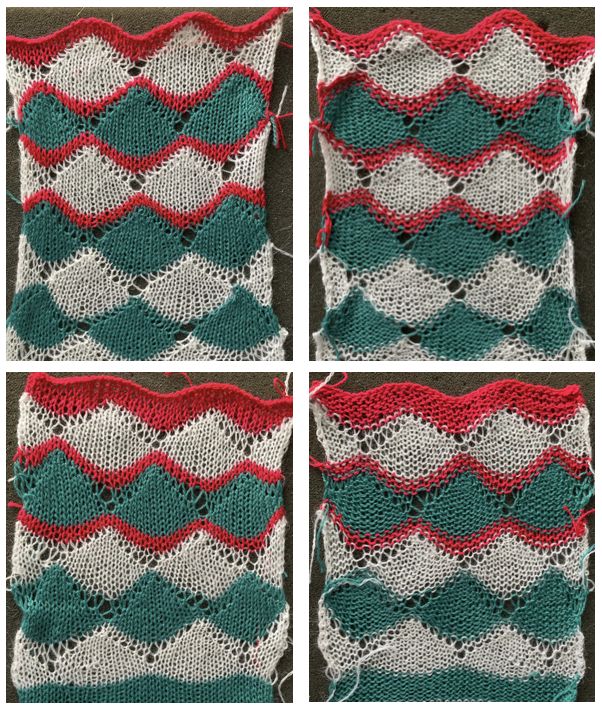 2023: a screen grab from the shell charts was cropped to its outline, opened in ArahPaint, and using the program’s tool “guess weave from grid“, the 36X98 png was obtained with a few mouse clicks,
2023: a screen grab from the shell charts was cropped to its outline, opened in ArahPaint, and using the program’s tool “guess weave from grid“, the 36X98 png was obtained with a few mouse clicks,

![]()
Isolating like modules and looking for any differences in each of them to prepare for a larger number of repeats across the needle bed in each half of the design  There are several methods for securing yarn ends both during and after knitting in the final pieces using these techniques. Testing such methods on swatches is the best way to determine what works for yarn and colors used as well as our own personal preference.
There are several methods for securing yarn ends both during and after knitting in the final pieces using these techniques. Testing such methods on swatches is the best way to determine what works for yarn and colors used as well as our own personal preference.
The pattern width may be adjusted to create considerably larger shells if desired. Punchcard knitters are limited to 8, 12, and 24 stitch repeats. For them, this would be the maximum size, including an added number of rows for contrasting color stripes, in this instance 4. 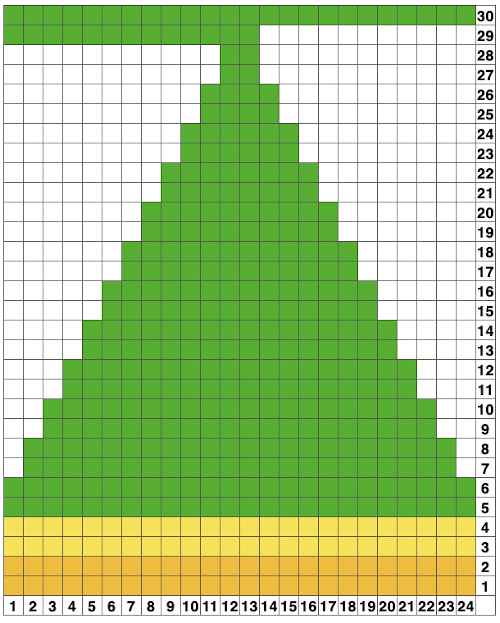 A return to the original 14 stitch repeat, illustrating a way to begin editing for an extra row in width at the bottom of the shape and ending on 2 stitches rather than a single stitch at the top
A return to the original 14 stitch repeat, illustrating a way to begin editing for an extra row in width at the bottom of the shape and ending on 2 stitches rather than a single stitch at the top Imagining adding increases and or decreases for shaping at sides, which in turn could lead to an evaluation of switching to entrelac approaches when creating large shell shapes for similar effects. The 3D qualities and distortions are obviously missing from these illustrations.
Imagining adding increases and or decreases for shaping at sides, which in turn could lead to an evaluation of switching to entrelac approaches when creating large shell shapes for similar effects. The 3D qualities and distortions are obviously missing from these illustrations.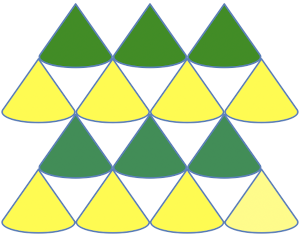
 A Prada sweater using similar shapes
A Prada sweater using similar shapes  If you are interested in any large size clamshells, and intarsia appeals to you whether in hand or machine knitting, Cheryl Brunette has thorough directions for many such shapes, including 2 videos on shell shapes Part 1, and Part 2
If you are interested in any large size clamshells, and intarsia appeals to you whether in hand or machine knitting, Cheryl Brunette has thorough directions for many such shapes, including 2 videos on shell shapes Part 1, and Part 2
More online inspiration using large shapes:
from a Russian blog
 a hand-knit blanket from Garnstudio
a hand-knit blanket from Garnstudio 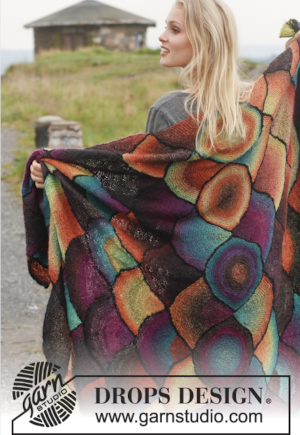 the common illustration for shaping triangular shawls using such motifs
the common illustration for shaping triangular shawls using such motifs  Similar pattern repeats are at times also referred to as scallops, fans, or scales. A “scallop” design
Similar pattern repeats are at times also referred to as scallops, fans, or scales. A “scallop” design  a “fan”
a “fan”
Sock knitting resources and ideas for machine knitting
The only sock(s) I have ever knit have been as demos in my classes. I actively dislike wearing them, and it winds up being a sheer necessity in our winters to actually break down and wear them. I have had an ongoing interest in 3D knitted, explored some pleating, have always been fond of holding techniques. This year has not allowed for as much time exploring and producing as I might have wanted, am hoping to increase both activities in the coming one.
Forums of late have buzzed with knit socks, here are some possible online resources: from machineknittingetc.com:
studio-tips-and-techniques-issue-37-charting-socks
 singer-sock-book-seamed-and-circular
singer-sock-book-seamed-and-circular machine-knit-news-machine-knit-socks-supplement
machine-knit-news-machine-knit-socks-supplement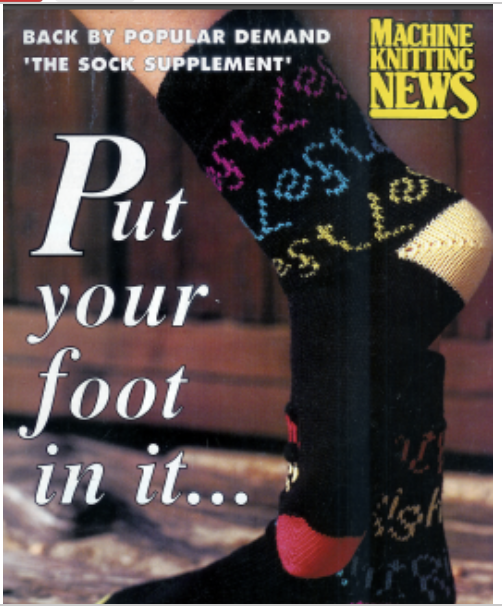 empisal-sock-patterns
empisal-sock-patterns

From assorted sources: visualizing shaping sequences: aspect ratio was disregarded in order to combine several images into a large one, particularly noticeable in the middle image on the top row 😉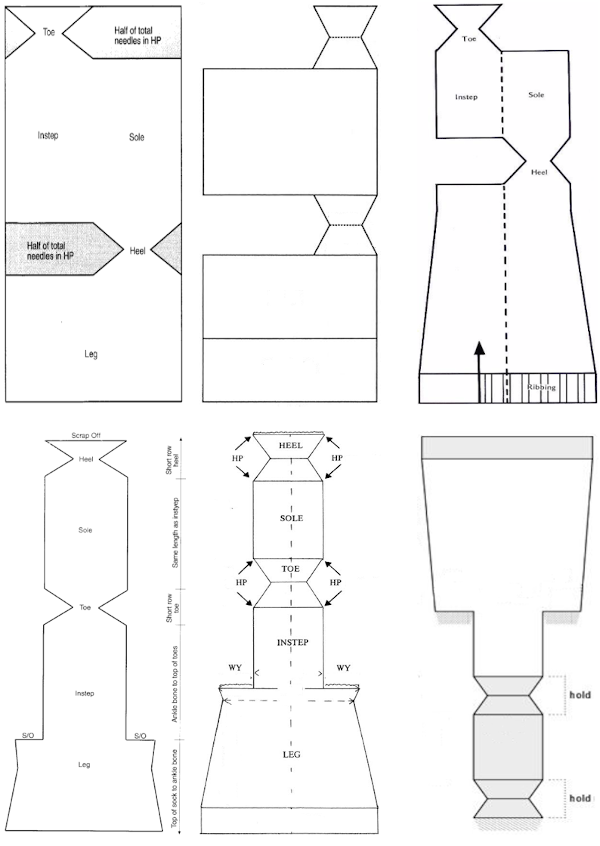 Patterns from manufacturers: Superba manual
Patterns from manufacturers: Superba manual 
 Passap Duo 80
Passap Duo 80 From a Brother pub. The original paper version actually came with knit leader patterns
From a Brother pub. The original paper version actually came with knit leader patterns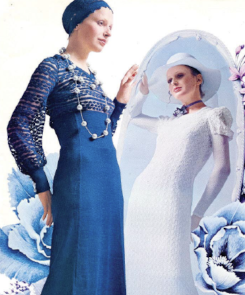
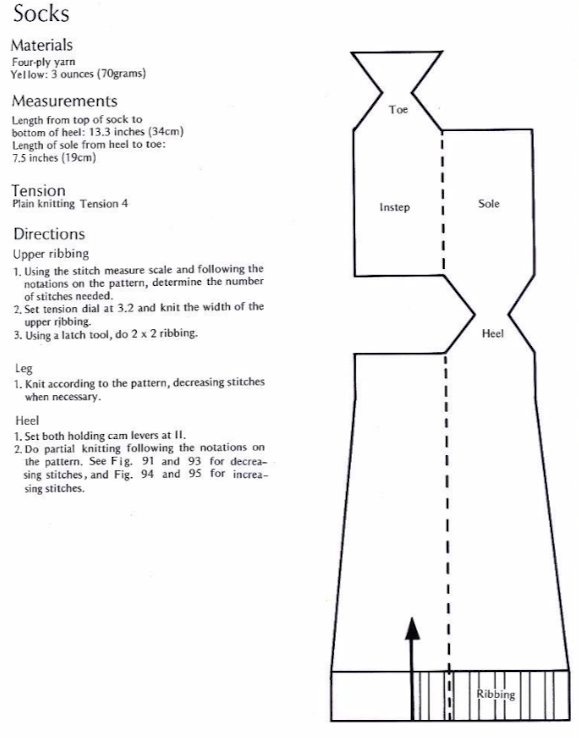
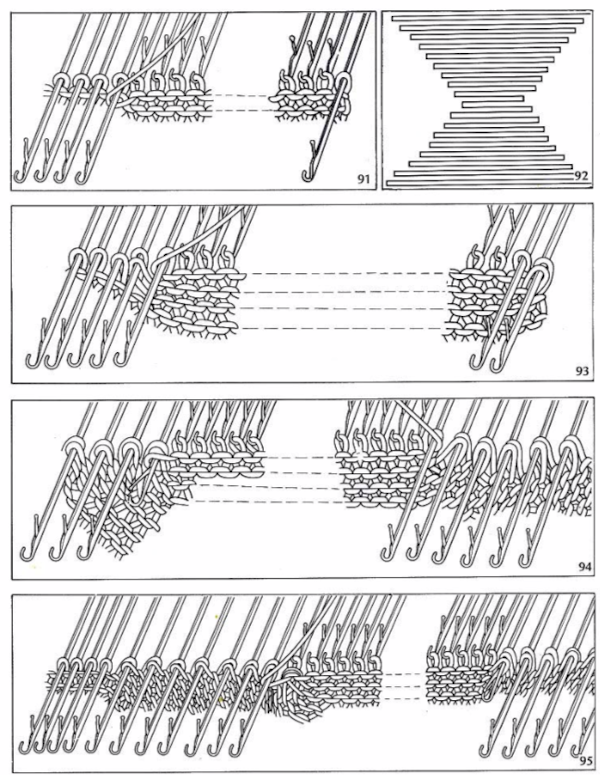

There are many ways to seam join such shapes. Seam-as-you-knit is another option. Diana Sullivan offers a video on the technique. Considering its limitations: the seaming needs to occur on equally shaped segments, this would eliminate any shaping to allow for widening parts of the leg as one moves up toward the knee, so the height of the sock would need to be shortened, planning for fit. If one desires a true rib at the top of the completed sock, IMO seams at least for the rib are unavoidable, and one must take measures to make certain cast ons and bind offs for ribbed bands match in look and width. The same issue with shaping occurs when knitting socks tubular. For a tube to grow or decrease in diameter retaining its circular form, the only way to achieve the result is to increase or decrease evenly across knitting bed(s) involved, far easier to achieve if one surrenders the seamless idea and allows for a seam in the design. Here A sections would be knit first, B sections would follow with seaming along the dotted lines. The toe is a 3D shape achieved by holding, with no seaming necessary.
If one is fond of holding intarsia techniques and cumulative joins, this book is available  For advice and ideas on knitting the swan socks see https://knitterstoolchest.wordpress.com/category/circular-knitting/
For advice and ideas on knitting the swan socks see https://knitterstoolchest.wordpress.com/category/circular-knitting/
a video link is included, as well as this schematic
 machine knit sock and slipper pattern resource
machine knit sock and slipper pattern resource
socks, heels, and more
eliminating short row holes
general instructions
penny socks
Sock calculators: http://roued.com/supersockcalculator.php https://www.goodknitkisses.com/sock-calculator/ https://www.storey.com/crochet-calculator/toe-up-sock.html
From Knitty, an online hand knitting magazine: universal sock article
A hand knitting resource on choosing your sock heels
From Drops design, HK, a spiral sock , and a side to side version, both food for thought in terms of adapting for machine knitting.
For folks who prefer videos, a search on youtube will offer lots of choices, and Roberta Rose Kelley offers 2 that provide a wealth of ideas and information, on tubular socks, the other on adding afterthought heels , using decker combs on Passap machines, transferring ribbed band stitches using a garter bar
Small scale experiments for larger ideas: the spiral sock
Mary Thomas’ book of knitting patterns was first published in 1943, my edition in 1972. This is the usual cover photo 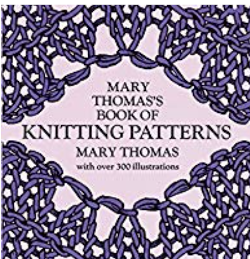 on page 38 a repeat and instructions are offered for a spiral tube sock. The latter has no heel shaping, but traditional toe shaping can be added.
on page 38 a repeat and instructions are offered for a spiral tube sock. The latter has no heel shaping, but traditional toe shaping can be added.  The knit/purl design can easily be executed single bed by folks who own a G carriage. My mini sock was knit on 30 stitches +1 for sewing. The blocks can be varied in width depending on the required circumference of the finished tube. The extra pattern stitch in the chart is to allow for seaming a half stitch on each edge and maintaining the pattern. *After every 6 rows knit transfer the right-hand needle of every ribber group to the main bed, on the main bed transfer the right needle of every group down to the ribber**, repeat * to ** for the desired length. There are a number of ways to deal with the toe part of the stocking. I would opt for transferring stitches to the main bed and knitting one row, using holding remove half the width onto waste yarn then bringing half the stitches on the alternate side into work. The toes may then be worked using stocking stitch, scrapping off, and seaming or grafting the stitches held on scrap to each other. My working repeat, with a 12 stitch repeat usable on punchcard machines as well isolated by the added green border
The knit/purl design can easily be executed single bed by folks who own a G carriage. My mini sock was knit on 30 stitches +1 for sewing. The blocks can be varied in width depending on the required circumference of the finished tube. The extra pattern stitch in the chart is to allow for seaming a half stitch on each edge and maintaining the pattern. *After every 6 rows knit transfer the right-hand needle of every ribber group to the main bed, on the main bed transfer the right needle of every group down to the ribber**, repeat * to ** for the desired length. There are a number of ways to deal with the toe part of the stocking. I would opt for transferring stitches to the main bed and knitting one row, using holding remove half the width onto waste yarn then bringing half the stitches on the alternate side into work. The toes may then be worked using stocking stitch, scrapping off, and seaming or grafting the stitches held on scrap to each other. My working repeat, with a 12 stitch repeat usable on punchcard machines as well isolated by the added green border  testing the tiling, making certain any programming would line up
testing the tiling, making certain any programming would line up  Cast on for a ribbed band at top of the sock in any preferred configuration. Be certain cast on stretches enough to accommodate the finished width of the tube as it stretches to fit the leg. Transfer stitches between beds in the desired knit/purl configuration. When the desired height is reached transfer all stitches to the top bed, drop the ribber, switch sinker plates, knit a row on all stitches, divide for toe shaping. Here one half away from yarn end and carriage is knit with waste yarn and dropped off when shaping is complete,
Cast on for a ribbed band at top of the sock in any preferred configuration. Be certain cast on stretches enough to accommodate the finished width of the tube as it stretches to fit the leg. Transfer stitches between beds in the desired knit/purl configuration. When the desired height is reached transfer all stitches to the top bed, drop the ribber, switch sinker plates, knit a row on all stitches, divide for toe shaping. Here one half away from yarn end and carriage is knit with waste yarn and dropped off when shaping is complete, 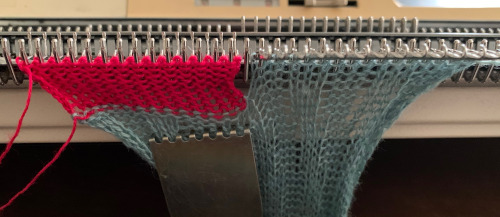
 After toe shaping is finished and waste yarn is added, the work is removed from the machine
After toe shaping is finished and waste yarn is added, the work is removed from the machine  Because all transfers are made in one direction, as in any knit fabric where that happens, the fabric will bias
Because all transfers are made in one direction, as in any knit fabric where that happens, the fabric will bias  Here the toe shaping is seamed, the twist in the body of the sock begins to show
Here the toe shaping is seamed, the twist in the body of the sock begins to show 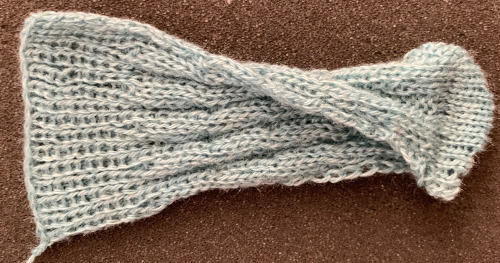 One side of my knitting was looser than the other, something to watch in any “real” piece. Thin yarn knit on tension 4 is probably also not the best suited for any socks in terms of wear. After seaming
One side of my knitting was looser than the other, something to watch in any “real” piece. Thin yarn knit on tension 4 is probably also not the best suited for any socks in terms of wear. After seaming  and worn by a few cotton balls 😉
and worn by a few cotton balls 😉 Lastly, it is possible to knit socks sideways (as well as gloves), usually in garter stitch and in hand knitting. This is a crochet illustration that points to the general construction method.
Lastly, it is possible to knit socks sideways (as well as gloves), usually in garter stitch and in hand knitting. This is a crochet illustration that points to the general construction method.
On the machine, the shaping would need to occur with increases and decreases rather than holding to create the heels, and toes could be shaped, probably best by full-fashioned increases and decreases. 
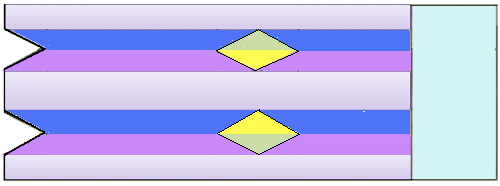 There would be at least one grafted seam the width of the sock, the cuff could be added with the side straight edge picked up and knit from there. To get shaping to match, in theory, one option would be to start with waste yarn, knit to half the above shape, scrap off. Rehang starting open stitches, reverse shaping, graft seam. Dotted lines represent open stitches, decreases and increases can be planned so that only the smaller group of stitches on one side are moved with a garter bar
There would be at least one grafted seam the width of the sock, the cuff could be added with the side straight edge picked up and knit from there. To get shaping to match, in theory, one option would be to start with waste yarn, knit to half the above shape, scrap off. Rehang starting open stitches, reverse shaping, graft seam. Dotted lines represent open stitches, decreases and increases can be planned so that only the smaller group of stitches on one side are moved with a garter bar 